A birthday card arrived in the mailbox.It came from my longtime friend J, whom I met while attending Pepperdine University (45 years ago). She drew a scene where we recently saw a movie on the card.The scene is as follows:Eric was buying our tickets, and the person selling them asked my friend J and me…
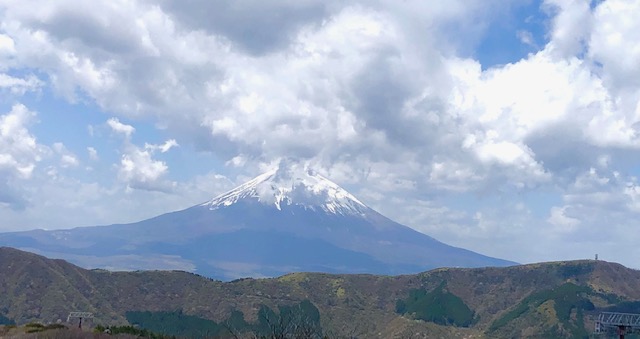
Japan Spring 2023 Diary Day 4 Hakone
My favorite thing about going to Japan is the hot springs and Shiatsu massage!
So this time, I made plans to go to Tenzan in Hakone Yumoto, where I went four years ago.
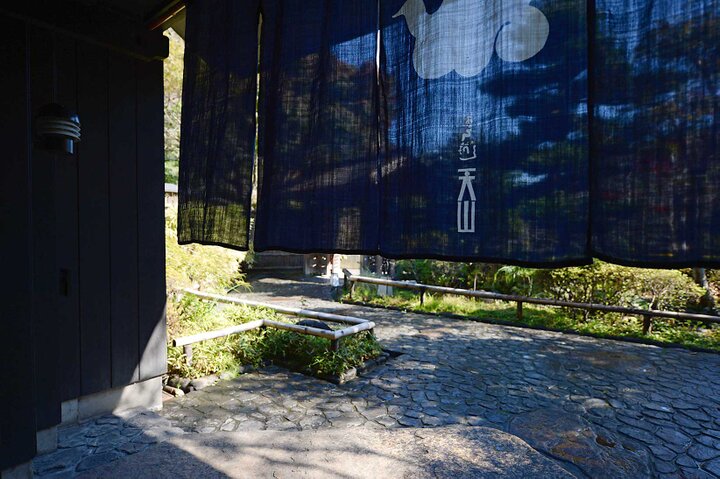
Meet up with a good friend, Chihiro, in Odawara.
She took us first to Owakudani – one of the most famous viewpoints in Hakone, where you can observe the intense volcanic activity from up close. It is said that this place came to be thanks to a phreatic eruption and pyroclastic flow that occurred almost 3000 years ago. It’s also known to locals as “Jigokudani” (the Valley of Hell) and is famous for its black eggs, which are boiled in the sulfurous waters to give the egg shells a distinctive color. The sulfur smelled so strong I had to wear a mask because I have smell sensitivity.
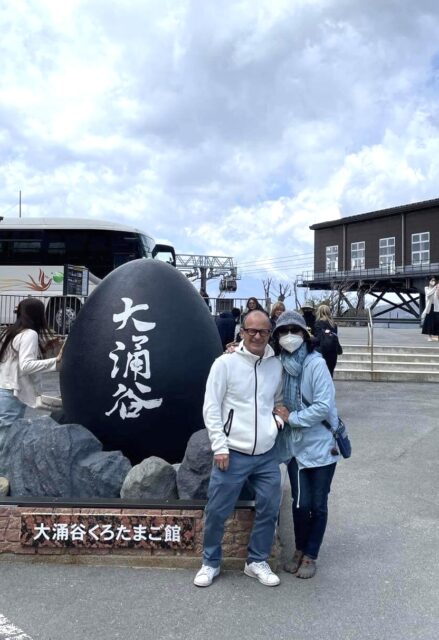
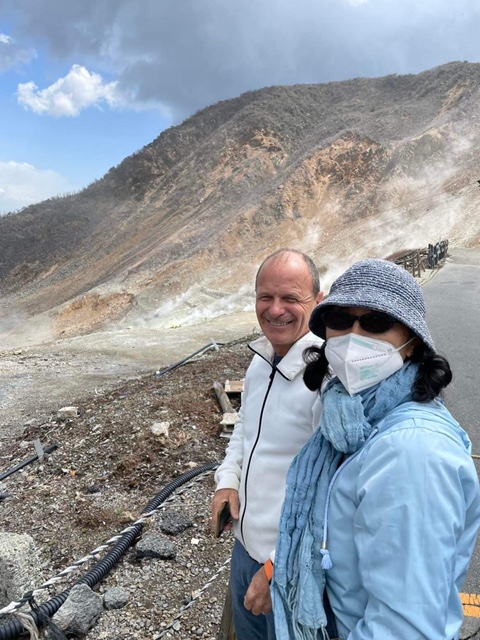
When we arrived at Owakudani, we could see Mt. Fuji, but it was behind the clouds, so we blew our breath to move the clouds away.
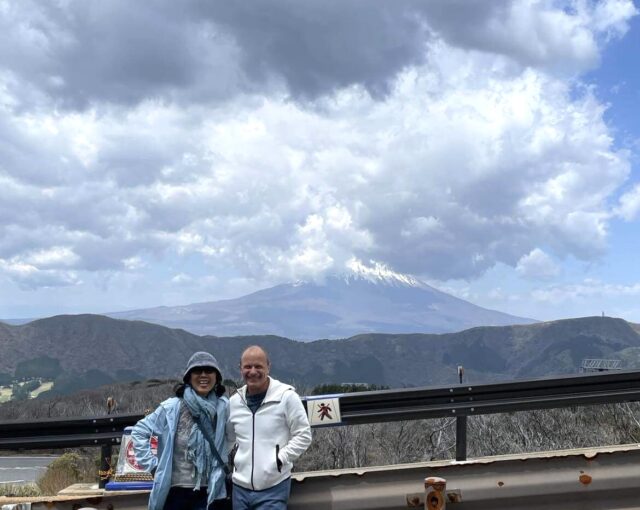
Did it work?
Sure, it did.

Four years ago, it was raining, and we could not see Mt. Fuji, so we felt blessed this time.
Mt. Fuji is the symbol of Japan and World Cultural Heritage.
I have memories of my father’s construction company building a road to the 5th Station (Fuji Subaru Line 5th Station), and I feel a sense of familiarity with Mt. Fuji. The Fuji Subaru Line 5th Station is located at an altitude of 2,300 meters and offers a panoramic view of the Fuji Five Lakes.
It is a popular spot even for those who does not climb the mountain climbing. While my father’s company was constructing the road, I was invited to see the breathtaking Mt. Fuji. I was moved to tears when I went to see the completion of the 5th station road a long time after my father passed away.
I’ve talked about this story with Eric many times, but someday I want him to see the road leading to the Fuji Subaru Line 5th station.
Chihiro drove to Ashino Lake, Shinshou Soba (opened over 50 years ago), for our lunch.
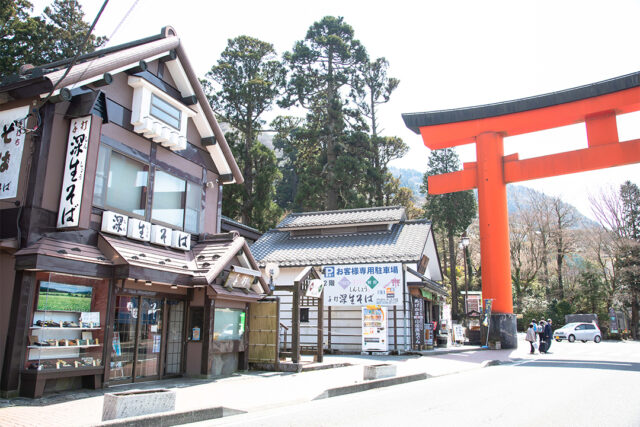
Usually, I don’t eat much soba because it is much denser than udon noodles. But Shinshou soba was smooth, light soba that I could enjoy. I had soba with grated jinennjo (wild yam). I had never had such thick jinennjo before. It was sooo delicious.)
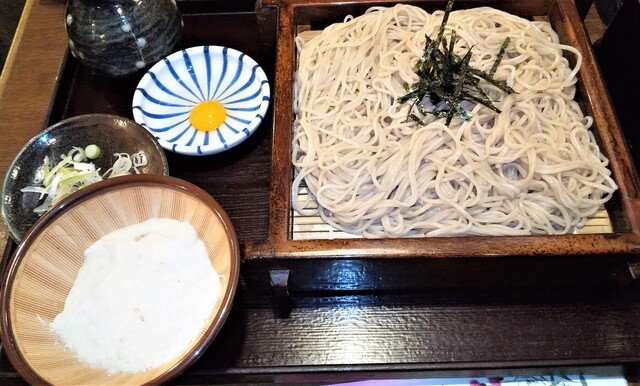
After a delicious lunch, we saw the beautiful mountain cherry blossoms, then went to our destination, Tenzan.
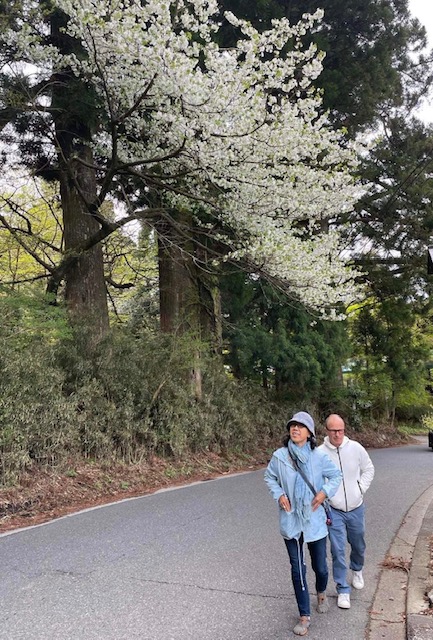
Tenzan has a great onsen (hot spring), massage, cafe, and souvenir gifts shop.
As soon as we arrived, first, we went to the massage room area to make an appointment to receive the massage after Onsen. There are many choices to choose massage style. I decided on the therapeutic Shiatsu and legs/feet combination. Eric and Chihiro chose the therapeutic Shiatsu.
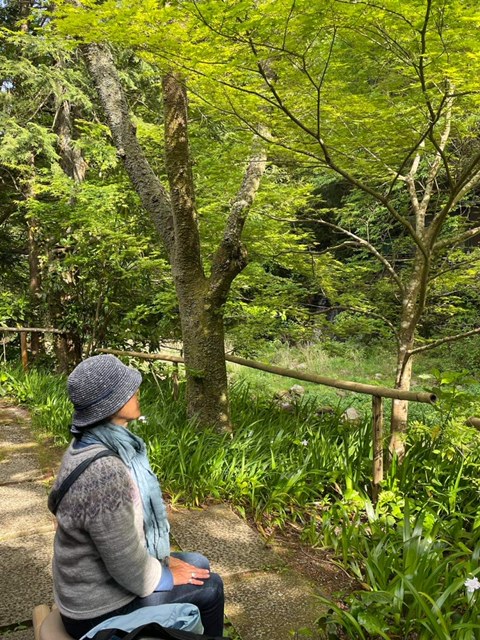
The Onsen is nature’s gift – it warms the body, heart, soul, and spirit and makes skin so smooth. Tenzan had an elegant wooden indoor bath and an open-air bath area surrounded by the forest’s trees outside.
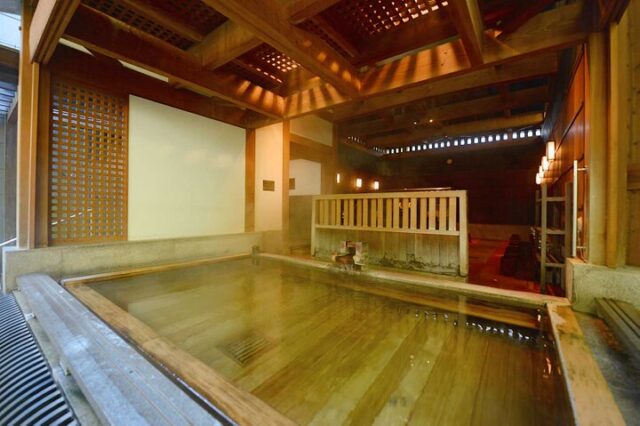

The last time we were there, Chihiro and I talked too much, dipping ourselves to enjoy Onsen too long, and we were late for our massage, so we had to make sure we won’t be late this time.
The massage was heavenly healing, and we were all satisfied 100% with big smile.
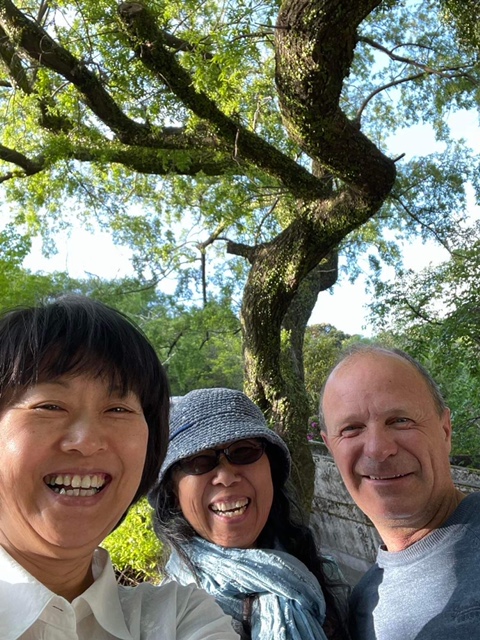

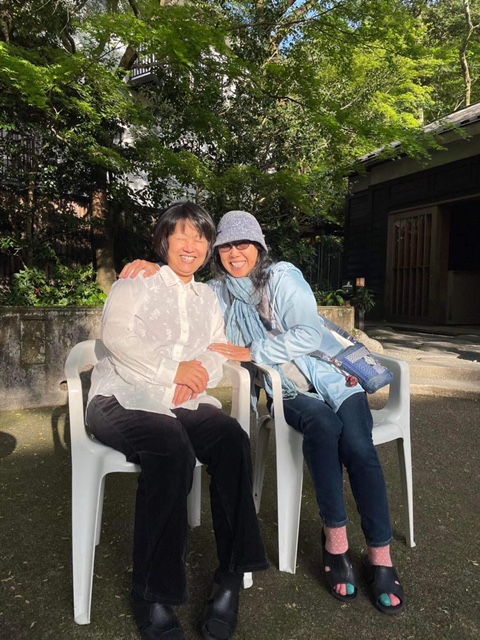
After the massage, we went to the cafe “Ukaregumo” (it means Floating Clouds).

The last time, I ordered a Red Shiso Juice since the weather was warmer. I liked it so much that I make it in Santa Monica in the summer, so I wrote the recipe on my blog.
, but it was still cool this time. I had homemade hot Amazake (a traditional sweet Japanese drink made from fermented rice) to warm my heart and sweeten my soul.
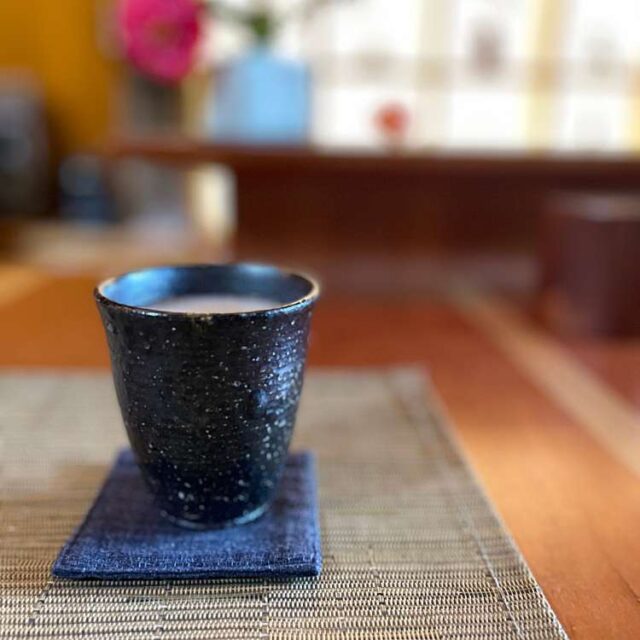
Eric had plum wine and chocolate tart.
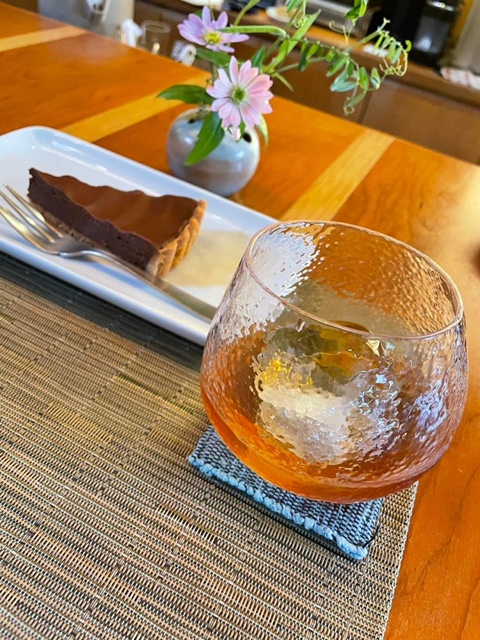
The hot springs are freshly brewed and can be drunk or brought back to your home in a bottle.
In general, hot springs have a high content of magnesium and have the impression of being “hard.” Tenzan [No. 74 hot spring] contains zero magnesium ions. The content of calcium ions is 1.2 mg in 1000 ml, which is very soft and has the property of super soft water.
I have another favorite thing to do at Tenzan – stop by their souvenir gifts shop, “Sharetei.”
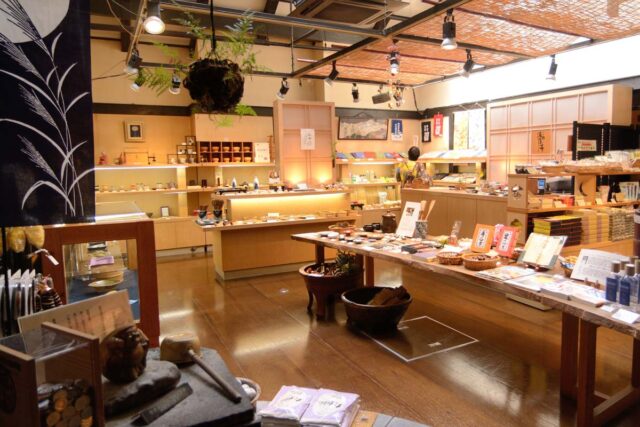
I love their unique, rare collection of items that can use in daily life. Just adding such a modest tool makes life fun.
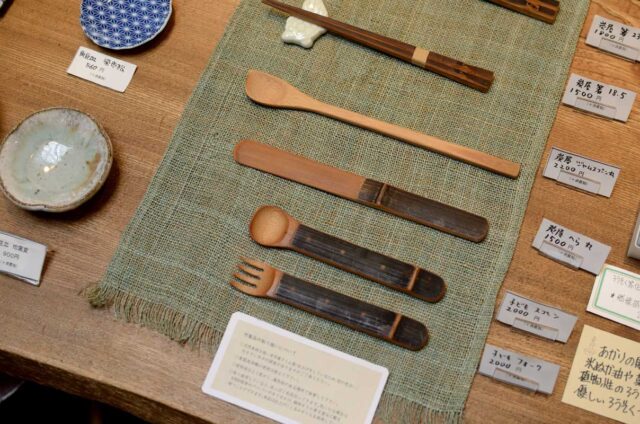
I found Zukou (a powder incense) with a cherry wooden container to put the powder incense this time. I have enjoyed incense since I was a teenager, but I didn’t have any powder incense, so I was excited. Powdered incense is applied to the body to purify the body.
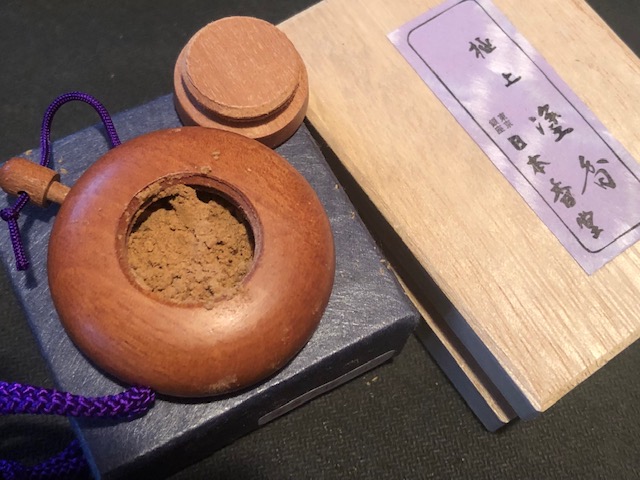
Agarwood, sandalwood, clove, cinnamon, and other precious herbal fragrant woods are used as a base to create a clean fragrance. Apply the incense to your hands and body when you hold a Buddhist memorial service or before you start copying sutras.
I decided to use the powder incense as a Japanese aromatherapy to soothe and protect myself.
These powder incent and a wooden box will be added to my treasures in Santa Monica.
Love,
Sanae❤️
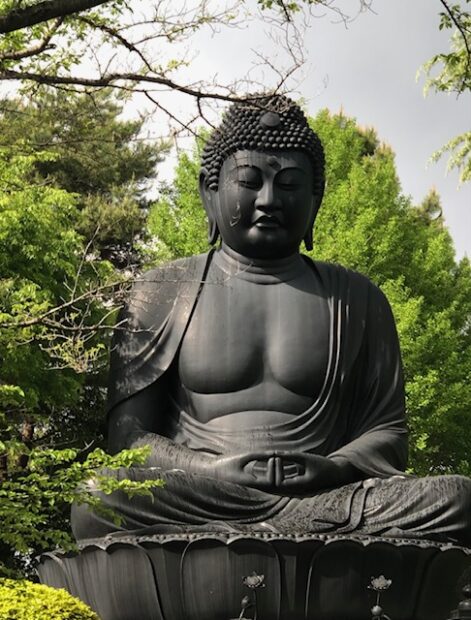
Japan Spring 2023 Diary Day 3 Tokyo
There are many hands-on classes in Japan to learn about Japanese culture.
On this day, I originally wanted to go to the hands-on Kintsugi class (Kintsugi 金継ぎ, “golden joinery,” also known as the Japanese art of repairing broken pottery by mending the areas of breakage with lacquer dusted or mixed with powdered gold, silver, or platinum; the method is similar to the maki-e technique.) early in the morning, but I decided to take it easy.
Sometimes, less is better, and I believe an opportunity to learn kintsugi will come in the future.
After relaxing and having breakfast, Ringo-chan and Shigeru-san accompanied us to the bus stop, and we took the bus to Futako Tamagawa station.
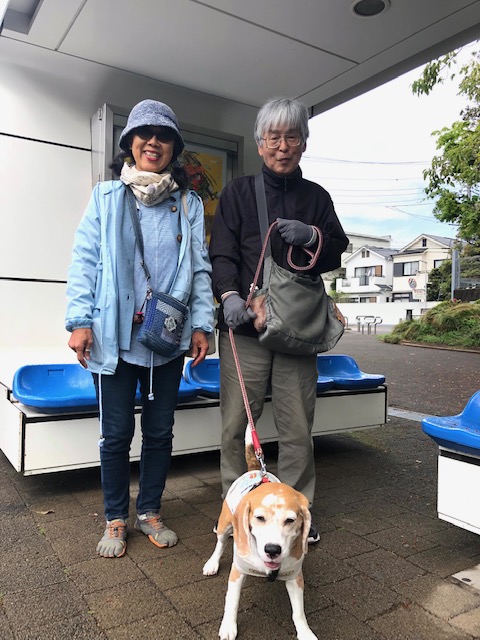
Our first destination was our favorite glass shop, JINS (4th floor of Futako Tamagawa Rise).
JINS is a Japanese glasses store established in 2001. I found out about JINS 5 years ago on a 2020 Tokyo TV show program. I saw JINS’ mission is to provide functional, innovative, and lightweight eyewear at affordable prices for everyone.
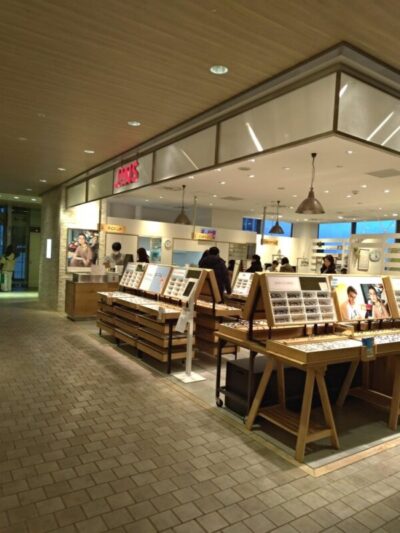
JINS frames are designed in Tokyo and carefully assembled with the spirit and passion of Japanese craftsmanship.
We went to JINS in Asakusa 4 years ago for the first time. Indeed, JINS was efficient, courteous, prompt, and reasonably priced. Eric liked it very much and was looking forward to going to JINS again to get new glasses made.
This time we chose 5 glasses. If we made 5 pairs of glasses in America, we would be bankrupt here in America, but it was less than 1/4 of the price there.
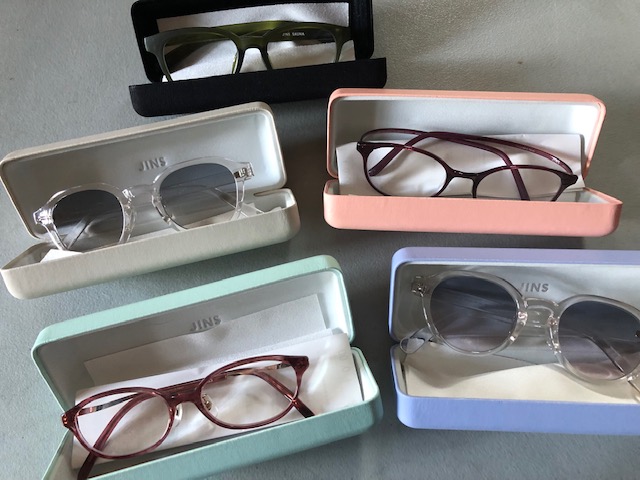
Eric chooses two cool bifocals. I have one for bifocals, one for computers, and one for craft/calligraphy.
While waiting for the glasses to be ready, we went to the “Bunkyodo” bookstore on the 6th floor for about an hour.
* Bifocal glasses take 1 week. In our case, JINS send it to our friend in Setagaya, and she will send it to Santa Monica. If you go to Japan and make bifocals at JINS, I recommend that you go there as soon as you arrive in Japan and pick up your bifocals a week later.
I love Japanese bookstores. A spacious and full of things other than books, where you can find something you did not even think to enjoy. Check out the calligraphy pens, ink, and Japanese paper, browse magazines and comics, and I could spend time all day there.
I only know a bookstore like the Japanese one is Burns’s Nobel bookstore on the third street promenade Santa Monica. I was sad when it closed.
When I was in a wheelchair, I often went there with my service dog, Kula. Checked out various magazines and books, grazed at photos of thick heavy hardcover photo books, and chose colorful stationery.
While I was focusing my viewing, Kula accommodated everyone and made them smile.
The Bunkyoudo had the same relaxing atmosphere; it reminded me of the nostalgic good time I spent with Kura at the bookstore.
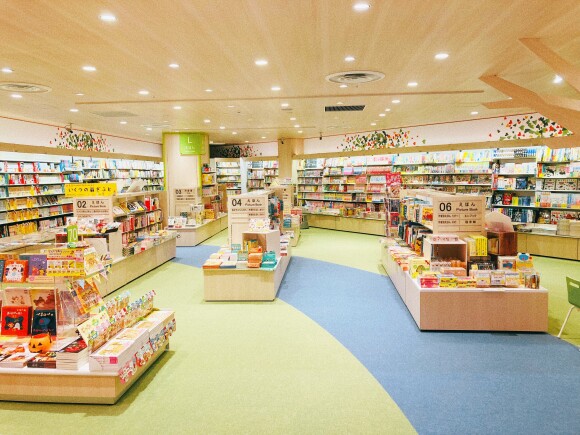
I was not looking for particular books, but I bought Snoopy’s book, “Snoopy Prepares Your Heart.”
This book explains Japanese quotes and Zen words.
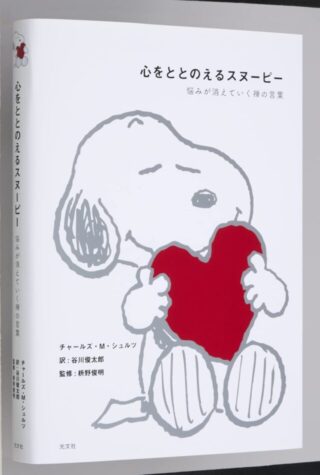 Peanut comics, which are drawn in black and white and have blank spaces, have something in common with Zen, and the lines of the characters that appear often overlap with Zen language.
Peanut comics, which are drawn in black and white and have blank spaces, have something in common with Zen, and the lines of the characters that appear often overlap with Zen language.
Even in silence, there is a world that is familiar to Zen.
An example given at the beginning of the book is the – Natural result.
“You just do it first and see what happens.”
This is one of my life mottos to live my life.
I learned English by reading Snoopy’s book when I was little, so I felt a connection with this book, and there was something I could learn from this Snoopy book again.
I had Snoopy’s book and Dennis the Menace’s book to study English. I also watched Sesame Street TV shows, listened to English music records, and translated the lyrics, which are fond memories.
Well, after the bookstore, we were hungry, and I was exhausted.
It was lunchtime, and there were long lines at all the restaurants, so when we were wondering what to do, we saw one restaurant called “Japanese Cafe Tsumugi” with almost no queues, and we thought this place might not be so good food.
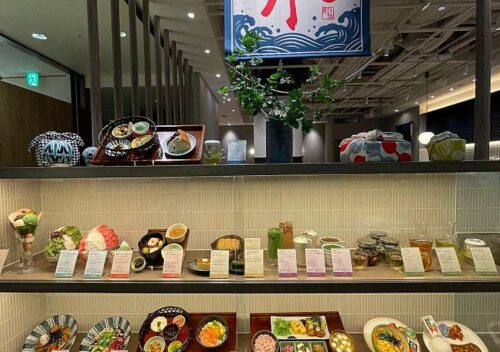
We decided to eat there anyway since we did not have much time. As for the taste, the food was fresh and delicious for us to enjoy it.

Thanks to lunch, I regained my sharpness a little. We went to pick up my three glasses, then took the Tokyu Den-en-chofu Toshi Line train and the JR line to Ikebukuro.
Ikebukuro station, where we were supposed to be, was not easy to find, and I got a little tired, so I was relieved to see Junko and her family.
When Junko was a student, she did a homestay at our house in Santa Monica to study English. We’ve known each other for a long time since Junko returned to Japan, and now she is married and has two children. Eric and I are so surprised to see her children grow up fast every time.
Our final destination and purpose for the third day were to go to Itabasshi to see Masaki, an old friend who worked as a chef in Los Angeles. We used to go to where he used to work every Fri. with other friends. The last time we saw him was almost 20 years ago in Shinjuku. Maybe I was in a wheelchair at the time. After that, he moved to Spain and New Zealand.
He recently returned to Japan and opened his new restaurant, “Space Cafe,” in Itabashi, Tokyo, and we promised to see him at his new restaurant.
Junko kindly chose where to go near Masaki’s restaurant with her husband, Hisashi, who used to live in the area.
We went to Tokyo Great Buddha (I did not know there was Great Buddha in Tokyo).
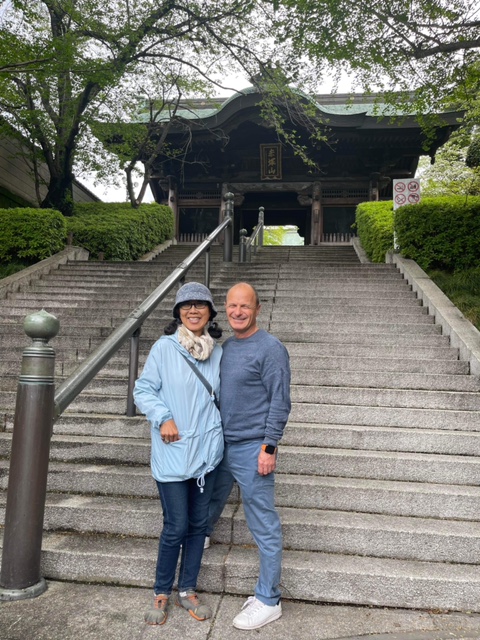
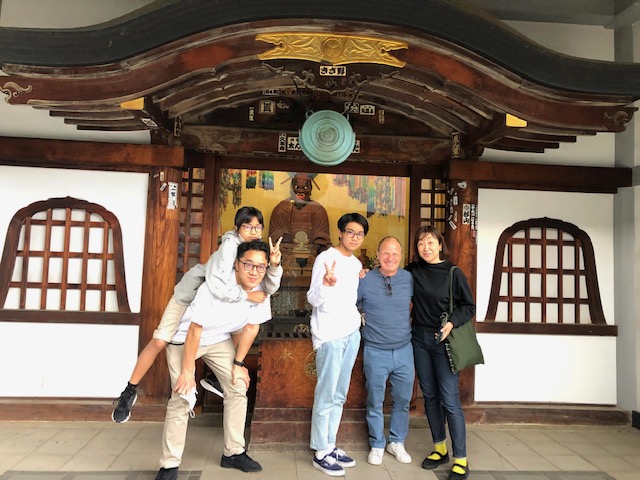
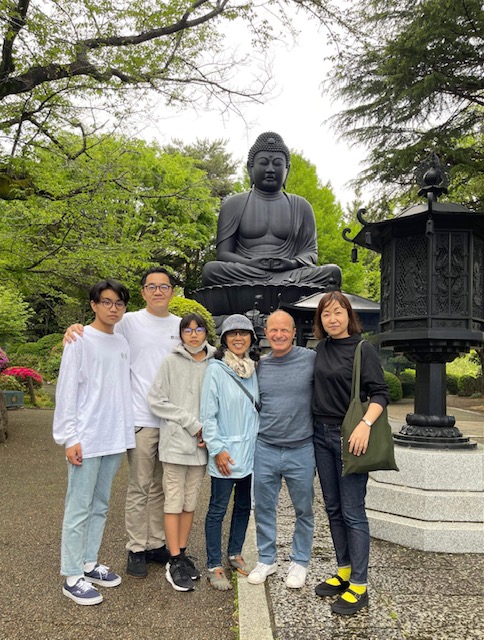
After some research, I found that the “Tokyo Great Buddha,” synonymous with this temple, is Amida Nyorai. The Tokyo Daibutsu Jorenji Temple in Itabashi Akatsuka, Tokyo, has a history of 600 years.
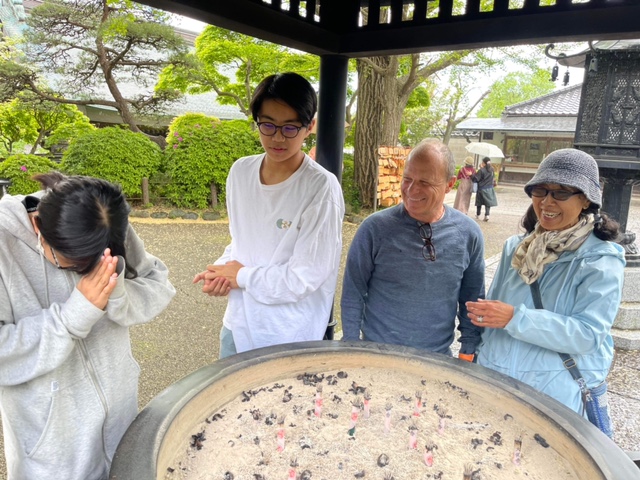
This temple was a resting place for the Tokugawa shogun’s falconry. The height from the base is 13 meters/42.6 feet, and the head alone is 3 meters/10 feet. It weighs 32 tons.
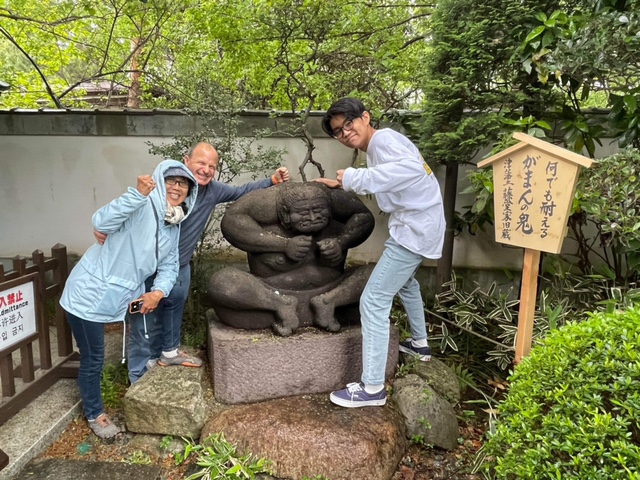
At the time of its completion, it was the third largest Buddha in Japan after the Great Buddha of Nara at Todaiji Temple and the Great Buddha of Kamakura at Kotokuin Temple.
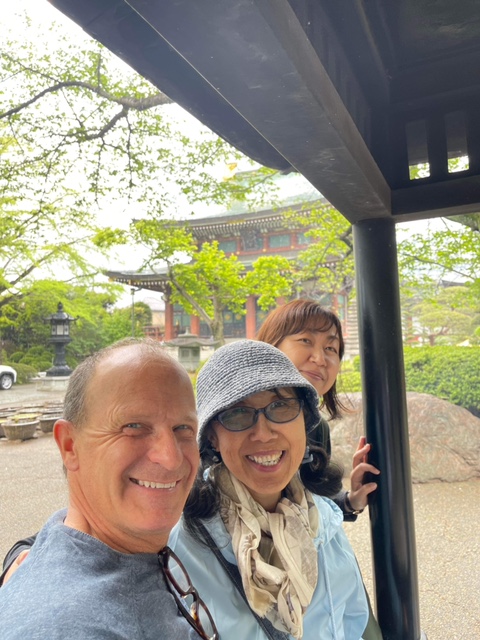
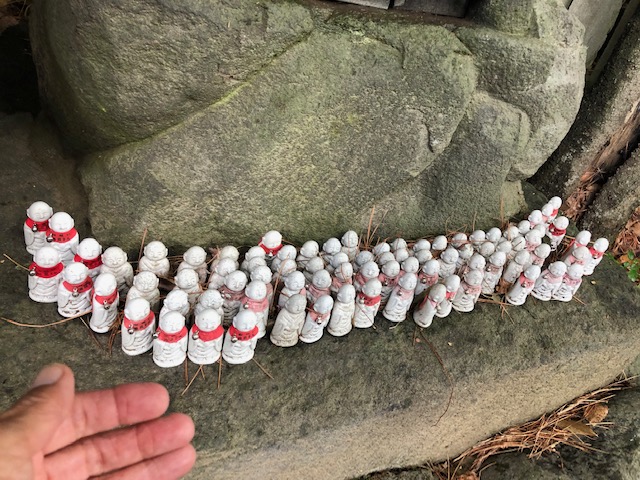
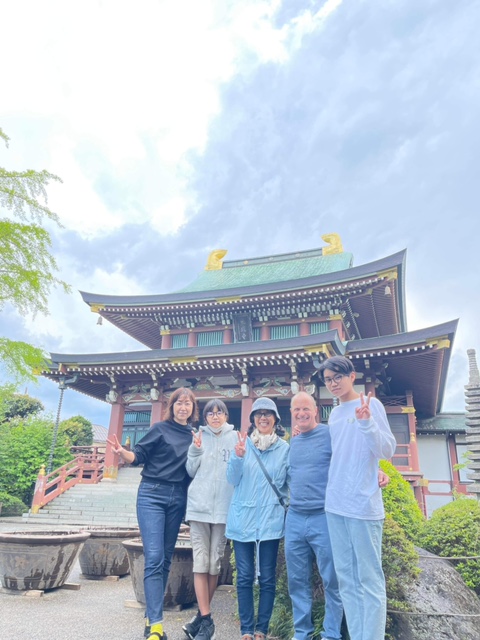
Amida Nyorai is the Buddha who created “paradise” to save people in a world without suffering. Please put your hands together and say, “Namu Amida Butsu.”
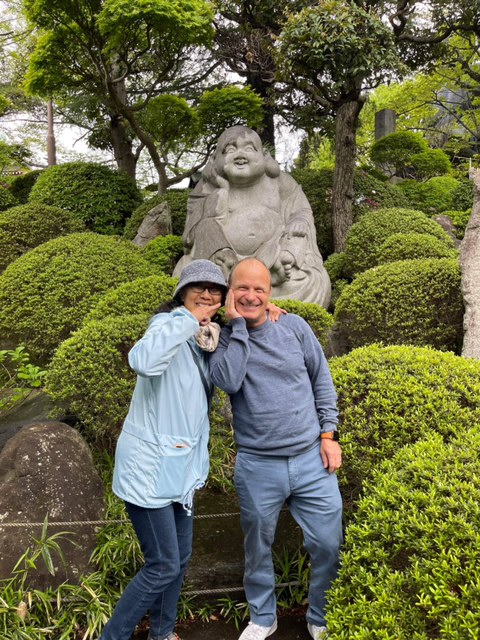
I have seen Great Budda, Nara Todaji, and Great Buddha, Kamakura, which are eye-opening Great Buddhas. The Tokyo Great Buddha looked softer, as if it had a gentle soul relaxing its vibrations in the busiest city, Tokyo.
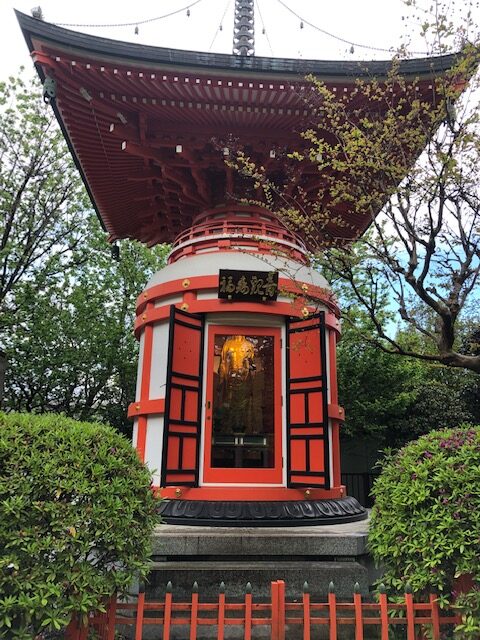
We took many pictures and had a great time with Junko and her family. Her son Ikkei danced on the ground of Tokyo Great Buddha to impress how good a dancer he was to us.

He wants to study abroad in America, so he might come to stay at our house like his mother, Junko. It’s a double memory that shares the past and the future. I hope it will come true.
After Tokyo Great Buddha, for my request to go to a botanical garden – they chose Akatuka Botanical Garden, a walking course blessed with nature, which was within walking distance from the Tokyo Great Buddha.
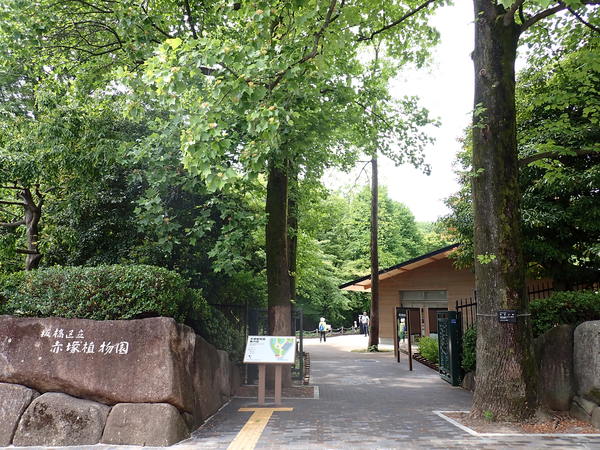
This botanical garden was opened in October 1981 as a facility that uses the hilly area of Akatsuka, which still retains the vestiges of Musashino, where nature and plants can be more familiar.
It started to rain, so we had to shorten our walk there, but it was the gift of nature: I gained my energy back and got ready to meet more friends.
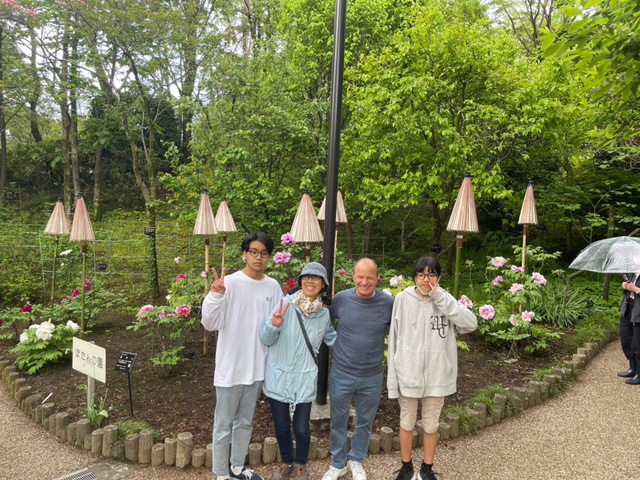
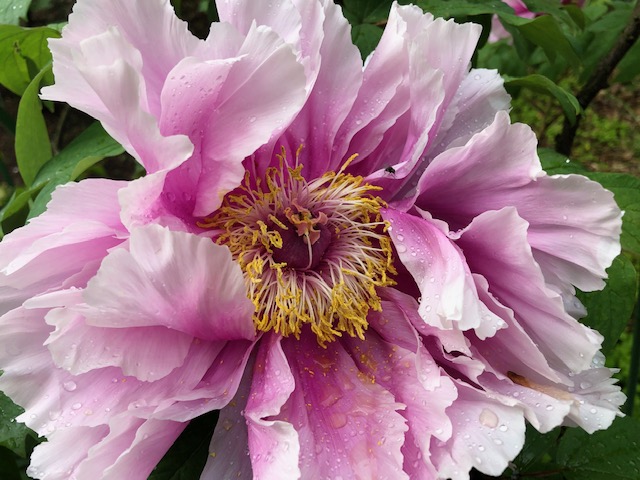
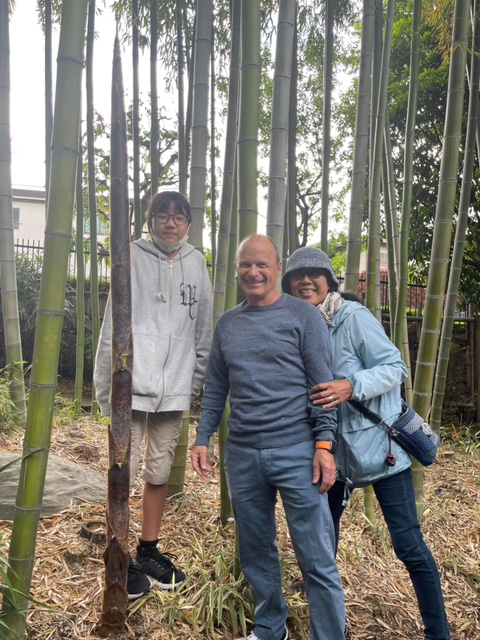
When we were driving by Masaki’s, the rain stopped, and he was outside looking up at the sky – he could not hear, but we called his name loudly, “MASAKI!”. Eric quickly got out of the car to surprise Masaki.
Masaki said later to us, “It might be a rainbow after the rain, so I was outside, but instead of the rainbow, Eric came!” with his big smile!!!
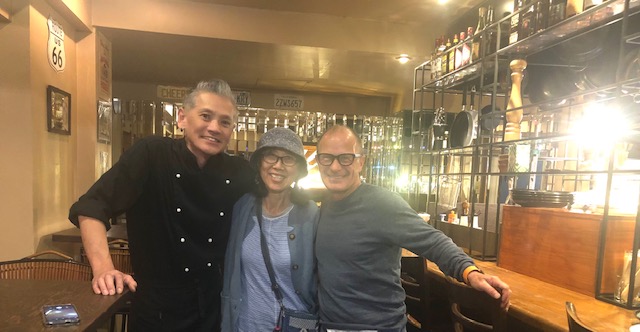
What a reunion for the first time in 20 years!
Masaki’s restaurant opened about a week ago, so he was alone greeting customers, taking orders, cooking, and cleaning up. We were so impressed with him.
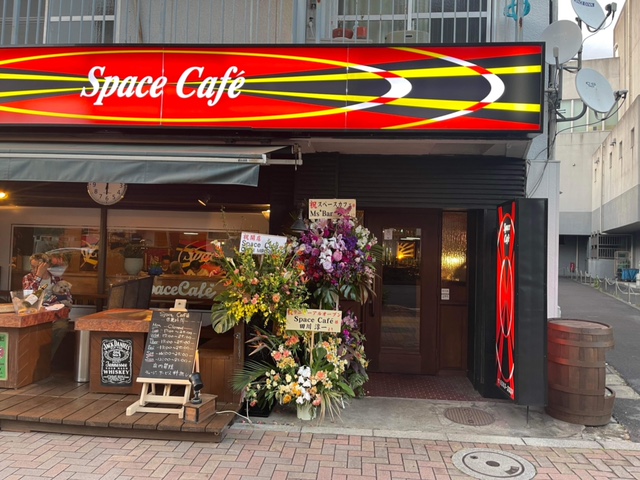
We also planned to meet up with Kuni and his wife, Kumi, at Masaki’s restaurant. Kuni used to work in Tahiti with Eric more than 30 years ago, and Kumi loves dogs, so I had a mutual connection.
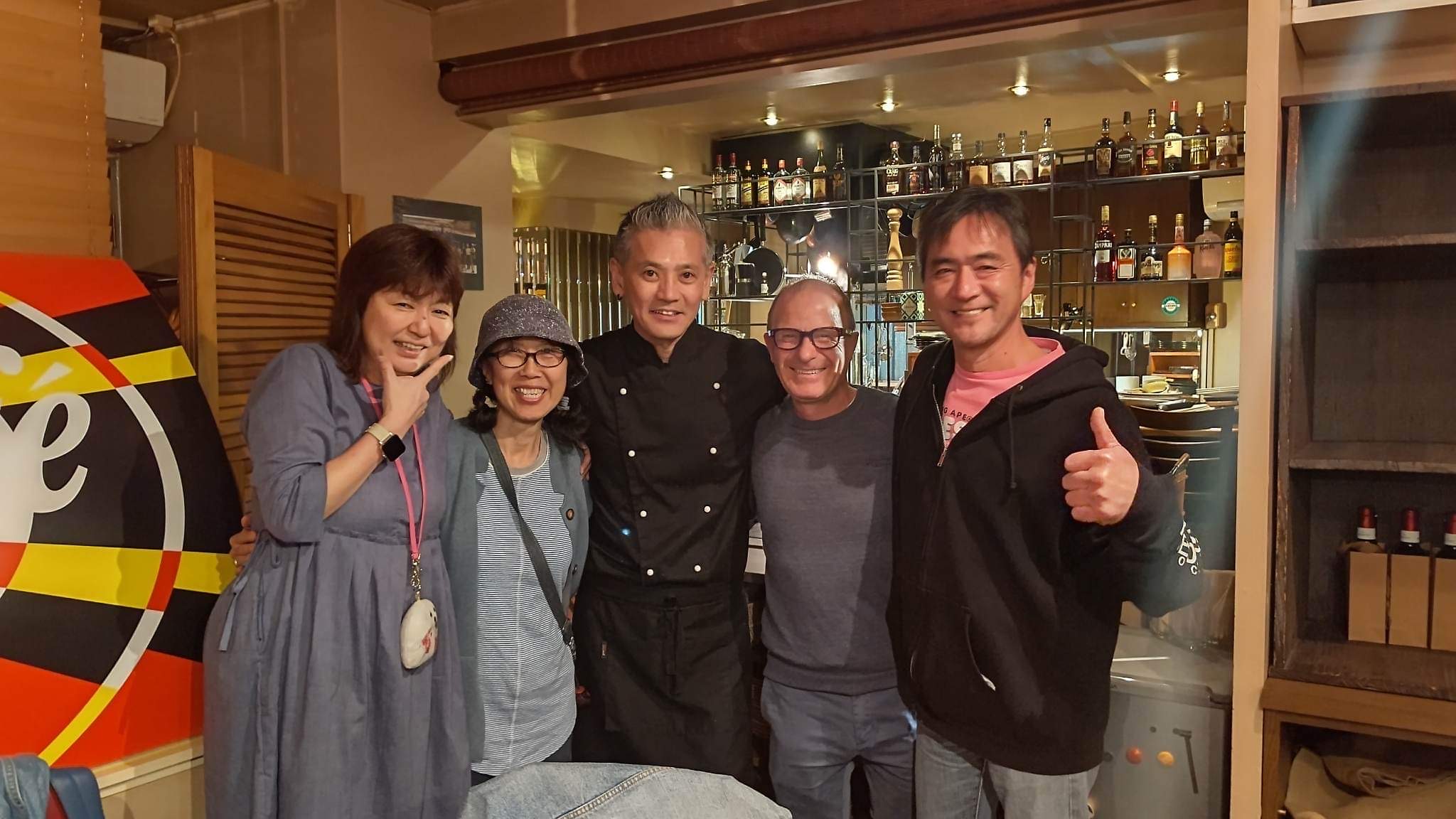
We all had such a great time with Masaki’s sophisticated, tasty food!
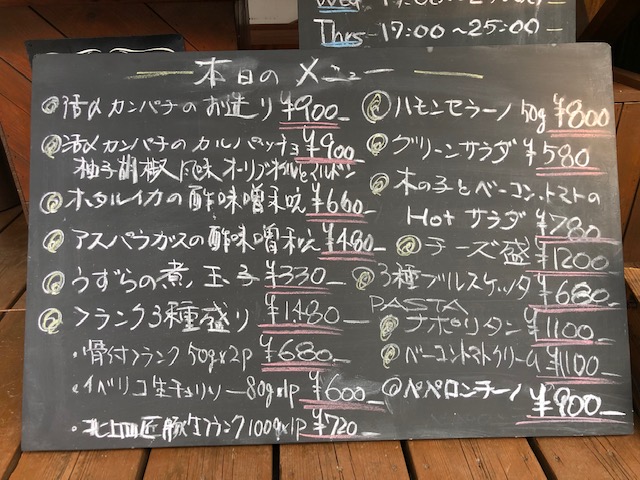
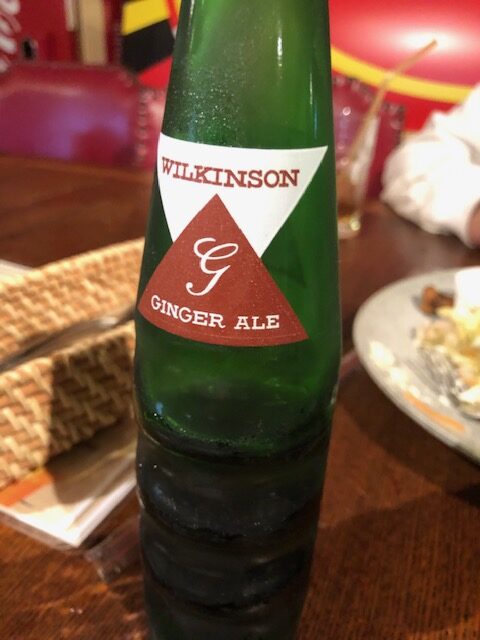
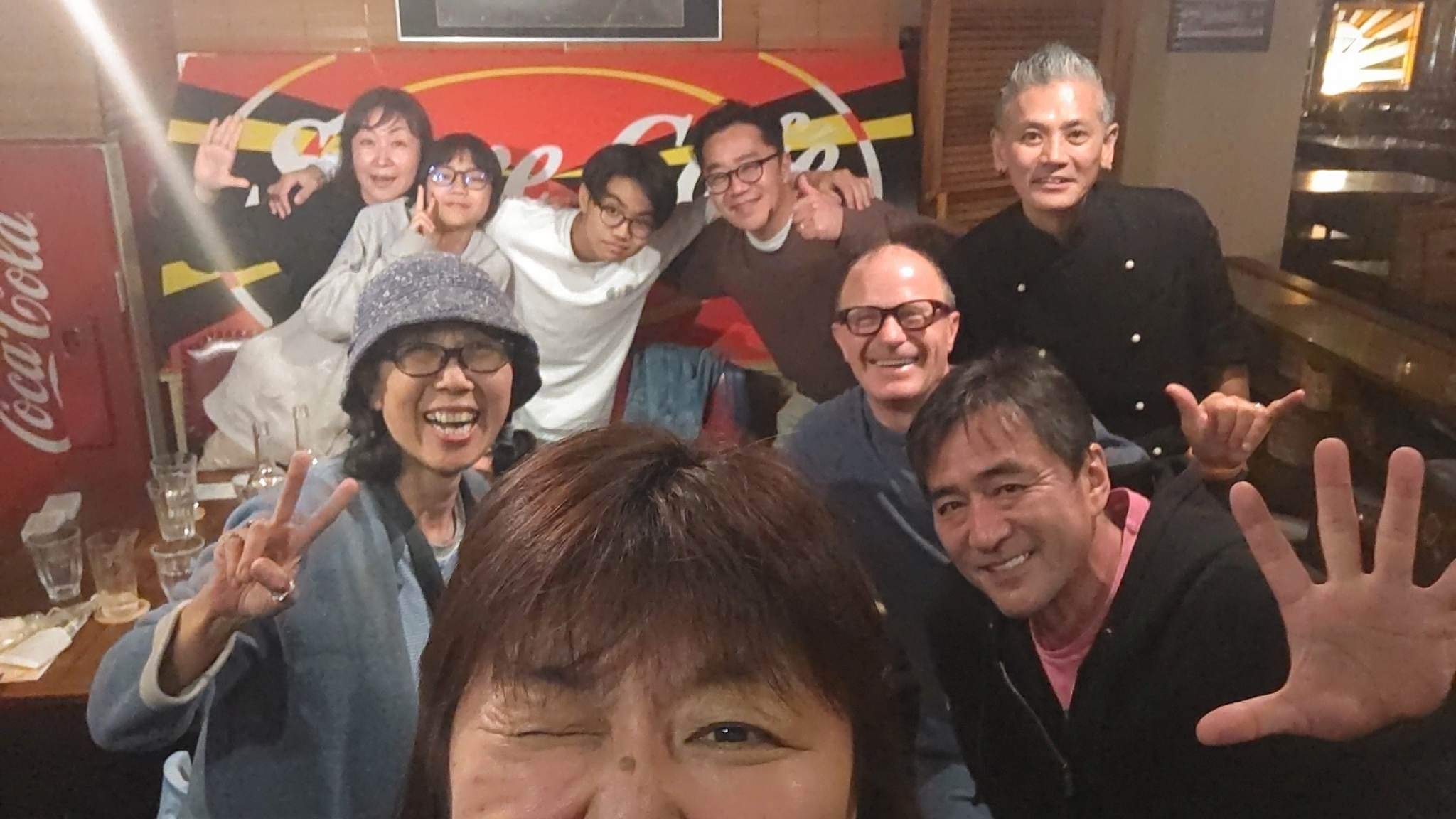
What a way to see old friends with good food!
After we left Masaki’s restaurant, Junko’s daughter, Mako, said, “How about Gelato?”
We stopped by A La Campagne near Soshigaya Okura Station on our way to Setagaya, where we were staying.
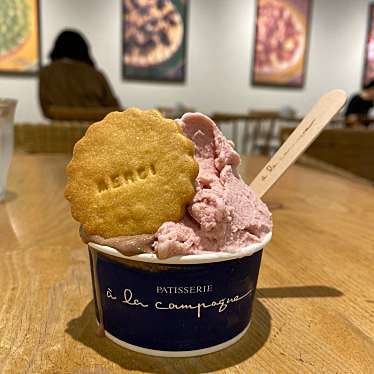
I didn’t eat gelato, but Eric bought me a cute bag for dessert.
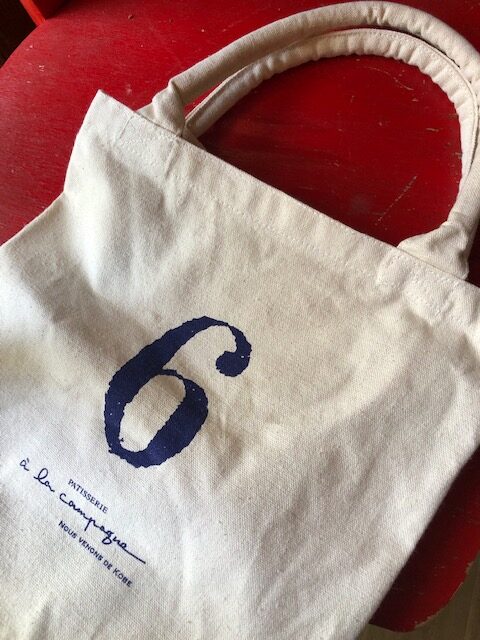
There are many cute shops around. When I passed by after gelato, the flower shop that caught my eye was called “Green Mind.” The next time, I definitely want to go there, so I’m looking forward to it.
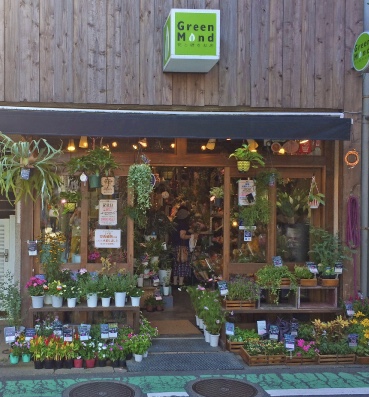
Well-planned and executed, unexpected things and plans for the future.
Ending the third day of my Spring 2023 trip to Japan was perfect!
Love, Sanae ❤️
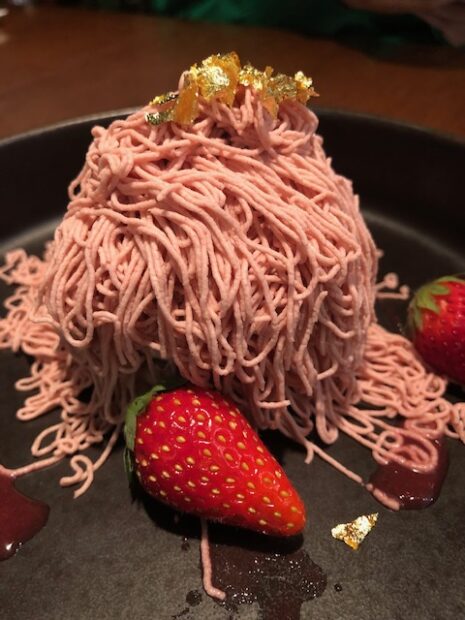
Japan Spring 2023 Diary Day 2 Chiba to Tokyo
On the first night of my spring trip to Japan, I fell asleep to the chorus of frogs, and on the second day, I woke up early to the sound of rain.
The spring rain did not seem to stop.
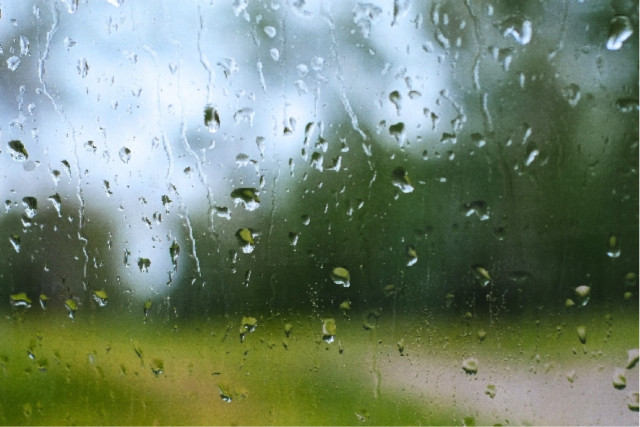
Eric and I were supposed to go hiking in Ubara Utopia with Deco-chan, Yamabushi (the thirteenth generation of the 400-year-old temple lodging “Daishobo” in the Temukai area at the foot of the three mountains of Dewa), and his students; of course, no more hiking.
After breakfast, Deco invited us to a local sound bowl healer session with Mr. Hoshino Sentatsu Yamabushi and his students.
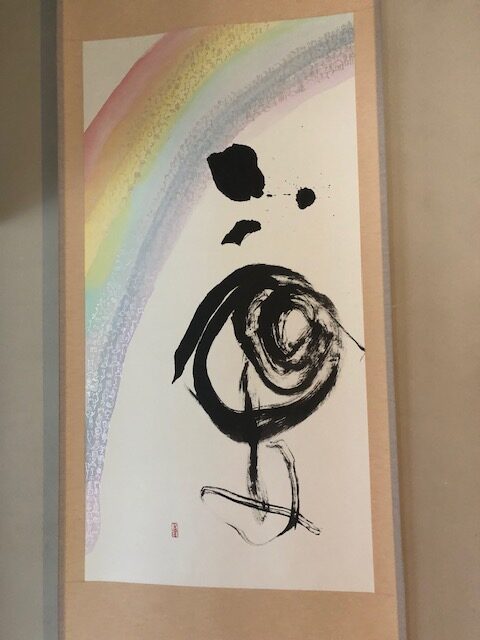
I forgot to tell Eric we were going to Singing Bowls Healing.
It was all in Japanese, and maybe Eric was new to Sound Bowls Healing, so I wondered how he felt.
After the session, all the participants shared their impressions individually, and Eric said, “The sound was soothing and connected to his heart.” What a perfect answer.
I am amazed at him once again.
I remember when he went on ten-day of Vipassana meditation; even though he first did not want to go, he came back home and said that it was challenging to sit for so many hours every day for ten days, but it was a meaningful experience to him.
Eric loves sports and is physically active, but he is not just a physical person, and still amazes me.
After the Singing Bowls Healing session, fortunate to see a tiny part of the healing work by Mr. Hoshino Sentatsu Yamabushi.
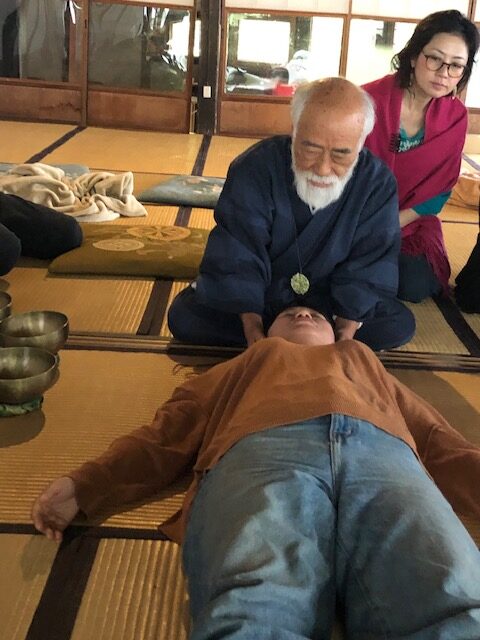
One of the joys of traveling is not knowing what to expect.
Deco took us to a bakery with a firewood kiln,” Acoustic,” open only on weekends.
There were delicious-looking bread and baked goods lined up in a cute shop.
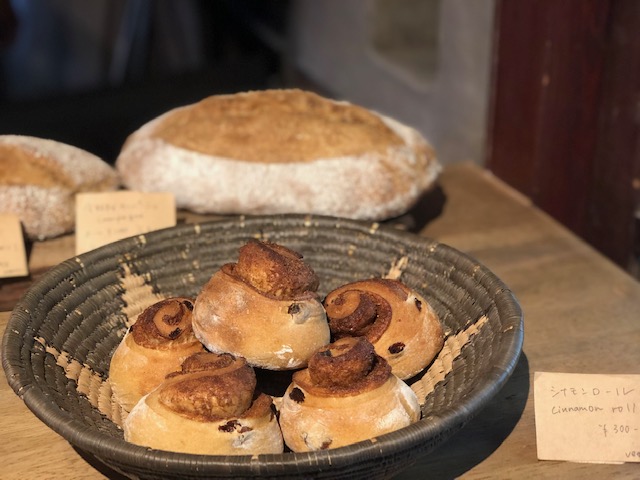
I wanted to eat them right away when I saw them, but I bought them for a snack for a train ride later that day.
Took a photo with the baker, his wife, and son.
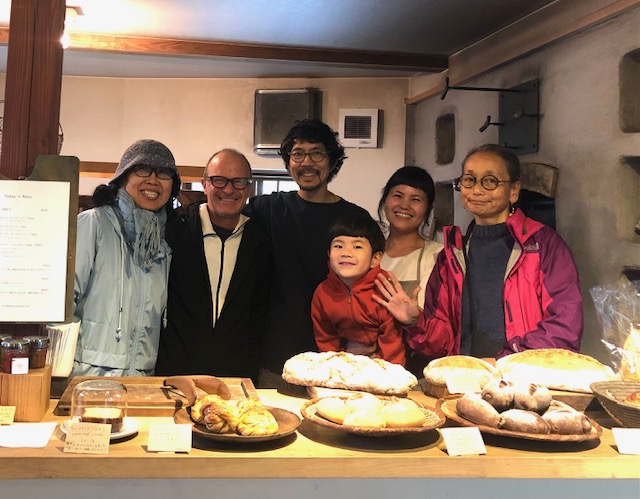
We shopped at Brown’s Field Rice Terrace Cafe, their new Brown Rice pasta, etc. We love pasta and can’t wait to try it when we get back to Santa Monica!
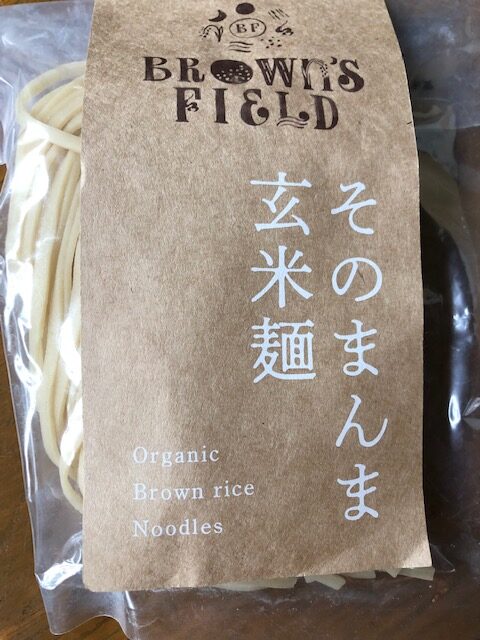
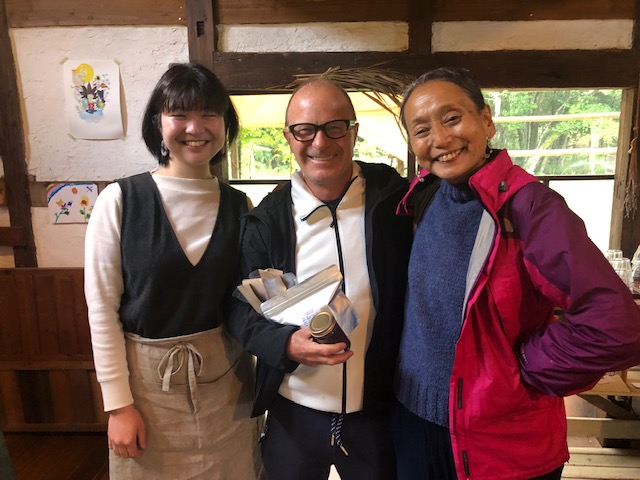
We ate the lunch box that we were supposed to eat on the hike while having a last fun chat with Deco-chan.
It was a short stay, but visiting Brown’s Field gave us strength and hope to come back there again.
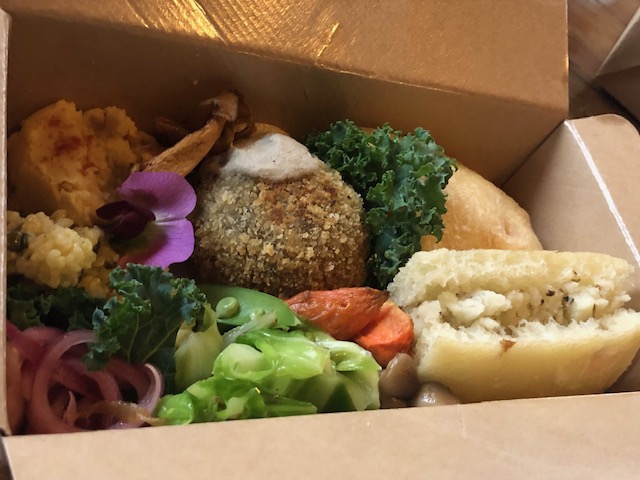
Took the JR Sotobo Line Wakashio to Tokyo Station. While riding the train, I ate “Acoustic,” a cardamon roll. It was so delicious each chewed.
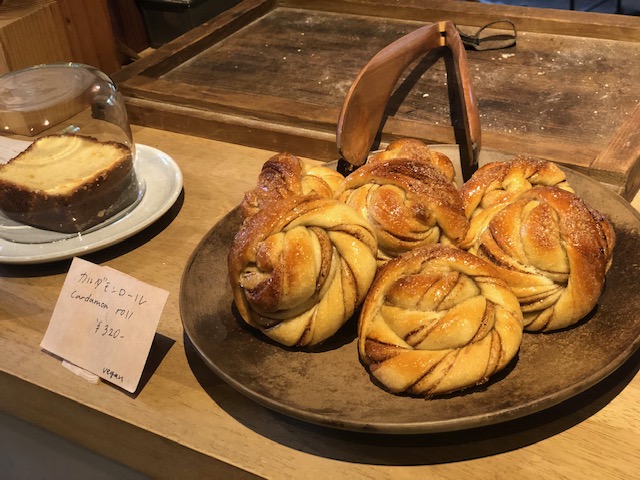
At Tokyo Station, one of Japan’s leading terminal stations, about 3,000 trains arrive and depart daily, and 400,000 people pass through the Monster station.
When we transferred to the Chuo Line, the crowds were so dizzying that I felt that I couldn’t breathe.
I had an aunt in Tokyo, and I often visited her from my parents’ house in Nagoya as a teenager. I enjoyed the visit but thought I couldn’t live in Tokyo because of too many people. The feeling got more certain.
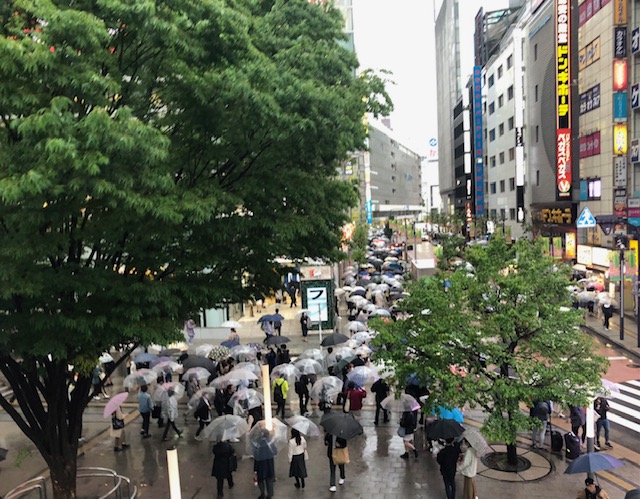
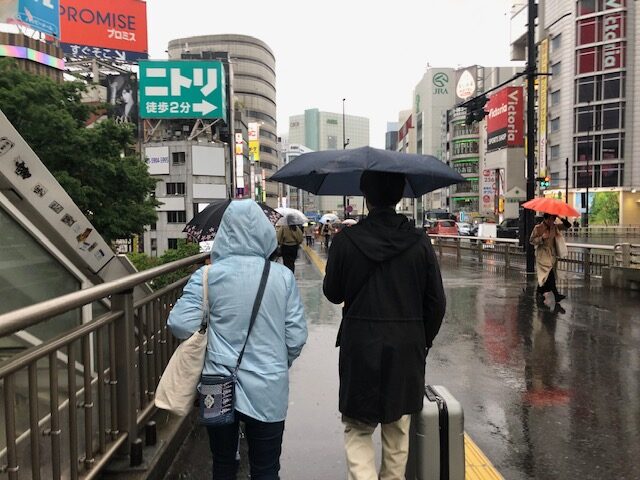
Arriving in Shinjuku, in the rain, we went to the green Italian restaurant “Torcia”
in the Isetan department store to meet some macrobiotic teachers and activists.

Trucha is a restaurant I went to twice when it was a Chayama Macrobiotics.
About a year and a half ago, Torcha opened as a vegan-friendly Italian restaurant where you can casually enjoy a vegan menu. The atmosphere mostly stayed the same, but everything has changed to Italian, and not only is it vegan, but the menu is abundant.
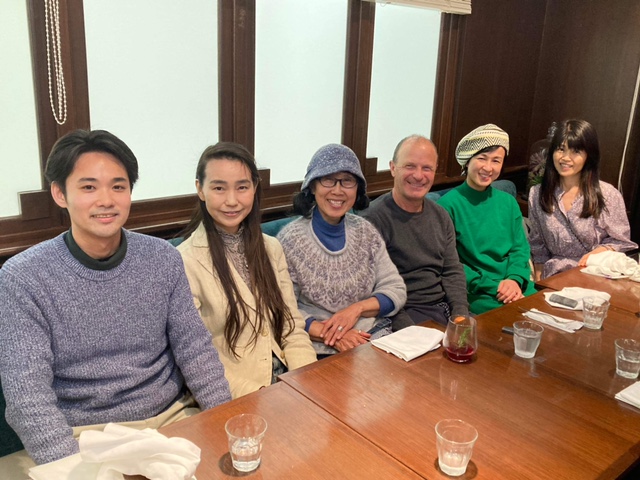
There were 7 of us, so we ordered all of the vegan menu items and tasted them. My favorites were and Strawberry Mont Blanc. It felt like 12 courses tasting menu!
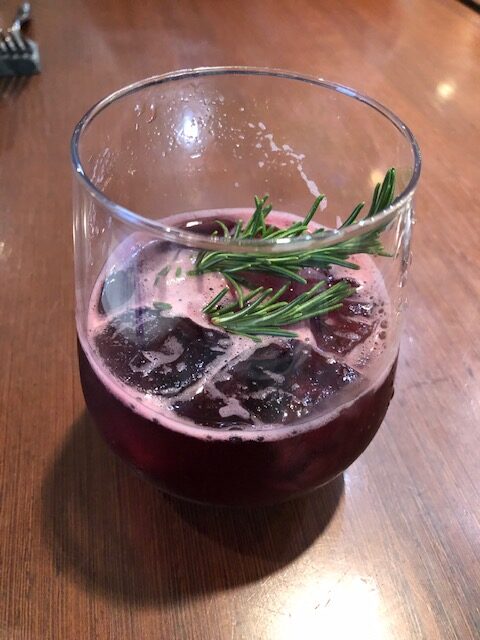
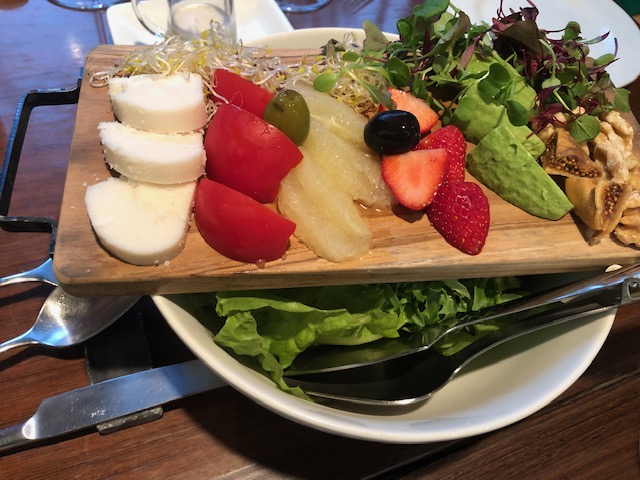
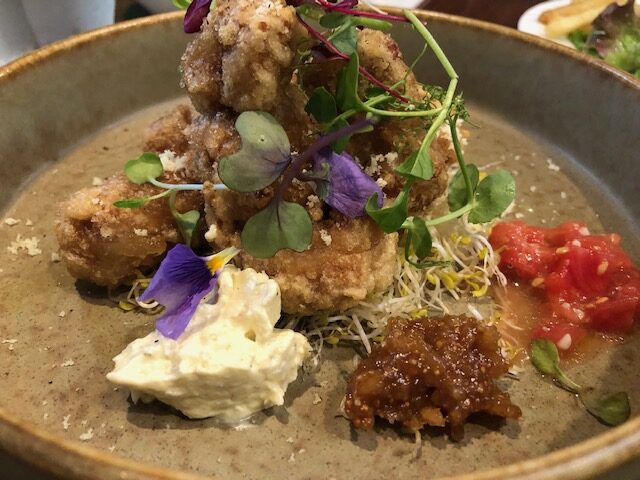
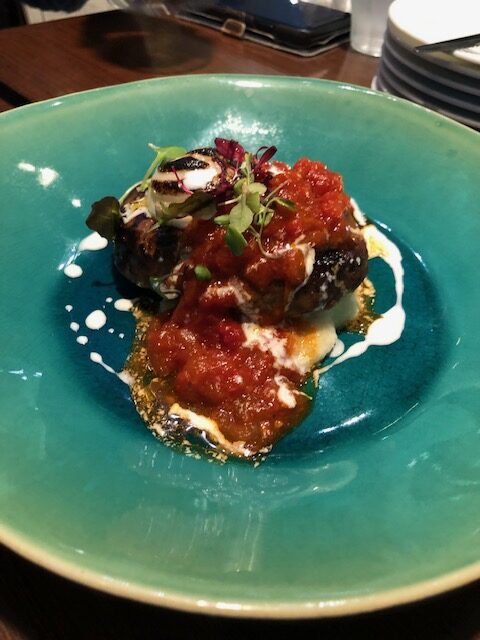
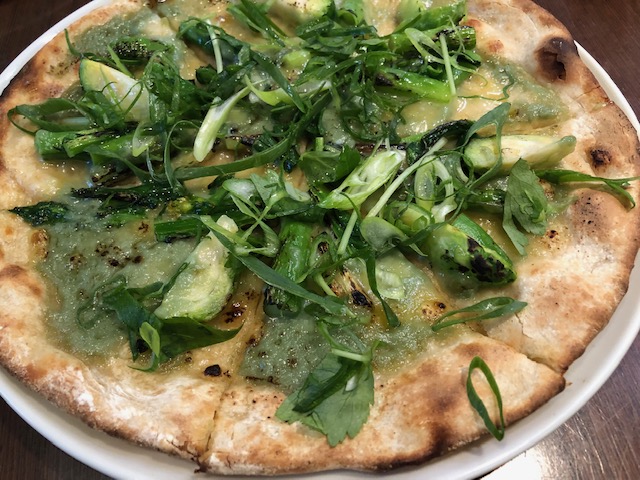
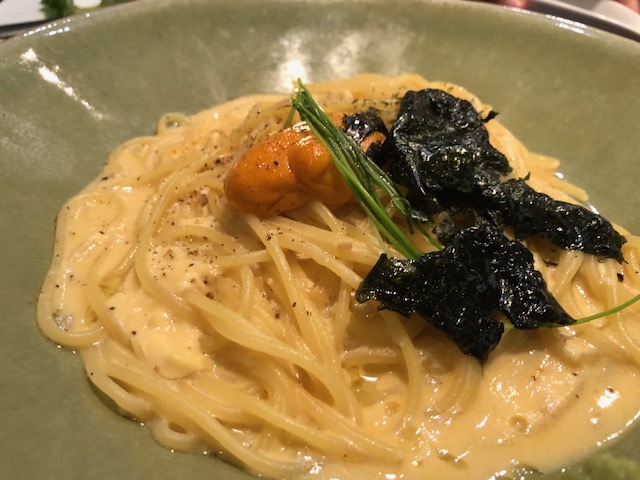
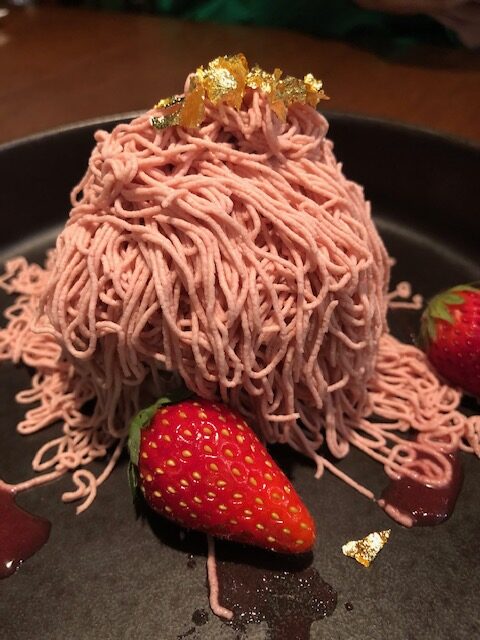
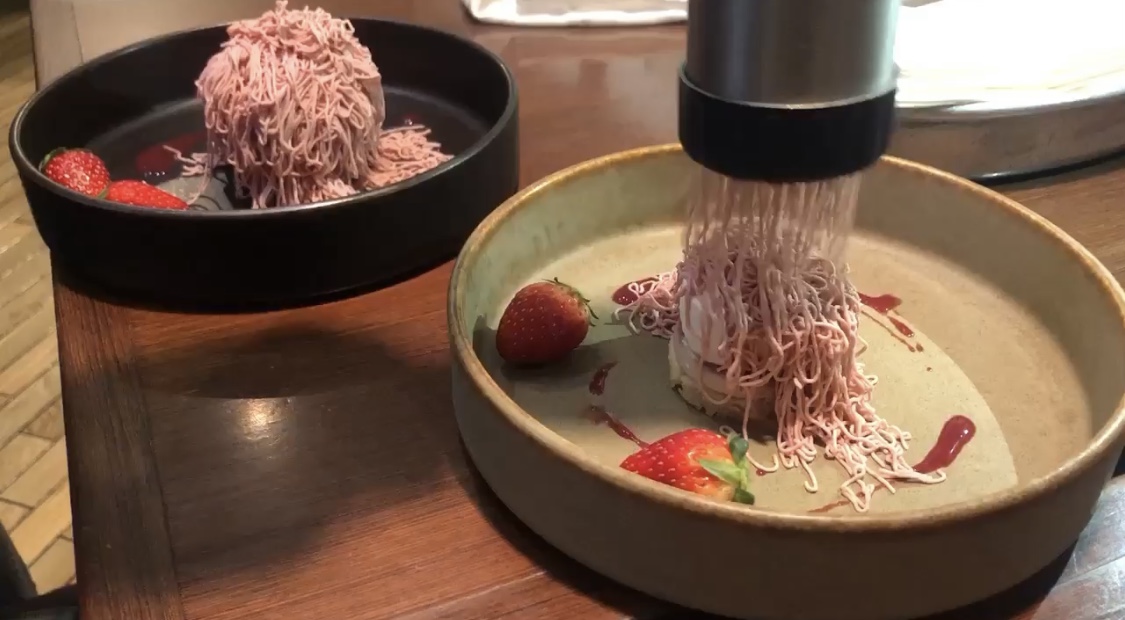
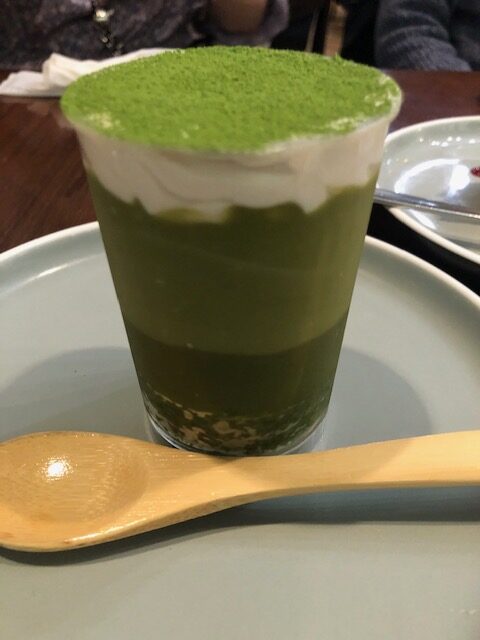
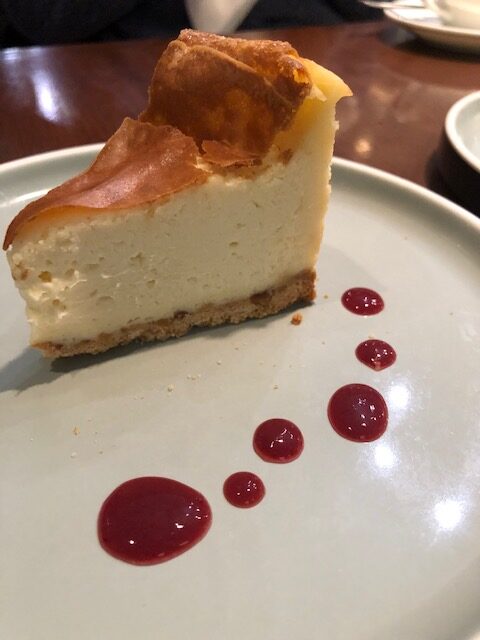
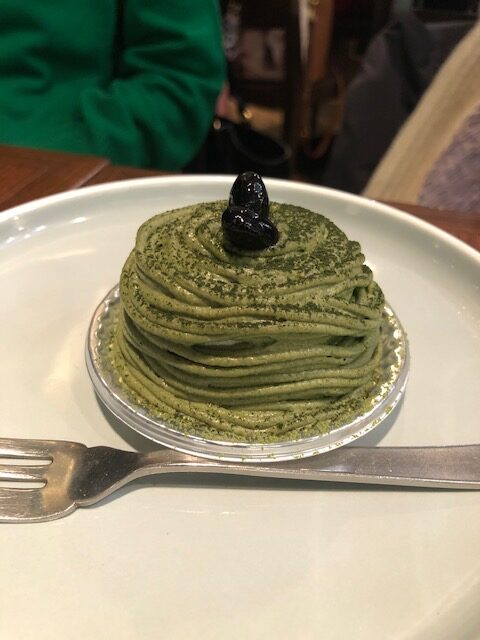
I was a little nervous at first meeting everyone because there were some people I never met before, but everyone was so warm and kind. They belong to the Japanese Macrobiotic Society “Wa no Kai“: Minaka Nagai, Yuko Sakurai, Miyumi Chiba, Shugo Nanabayashi, and Nana Arisawa.
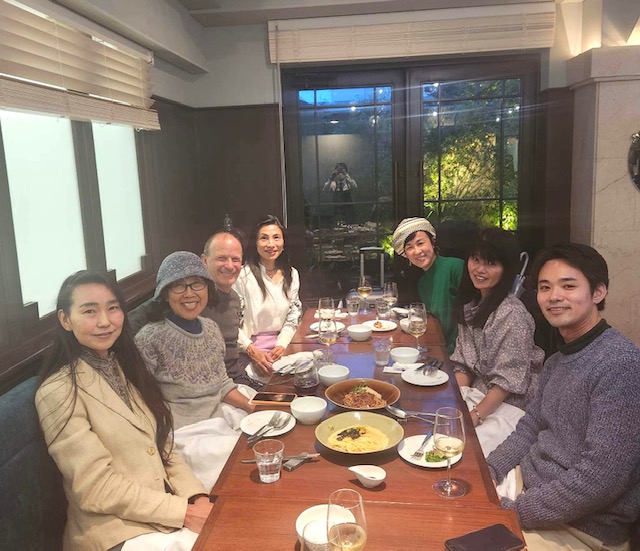

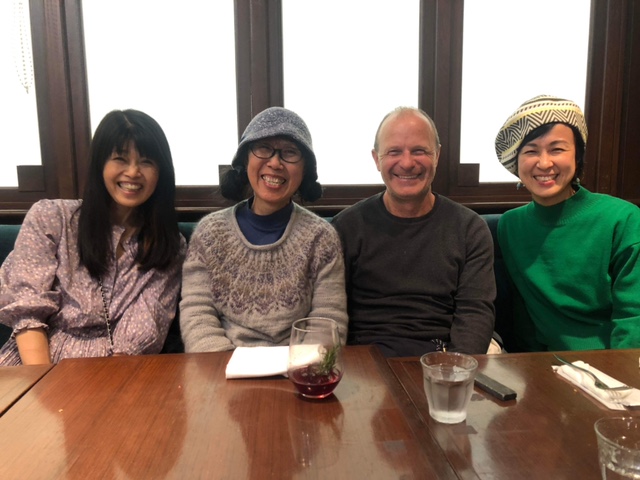
We had a good connecting time.
I was filled with gratitude for meeting them.
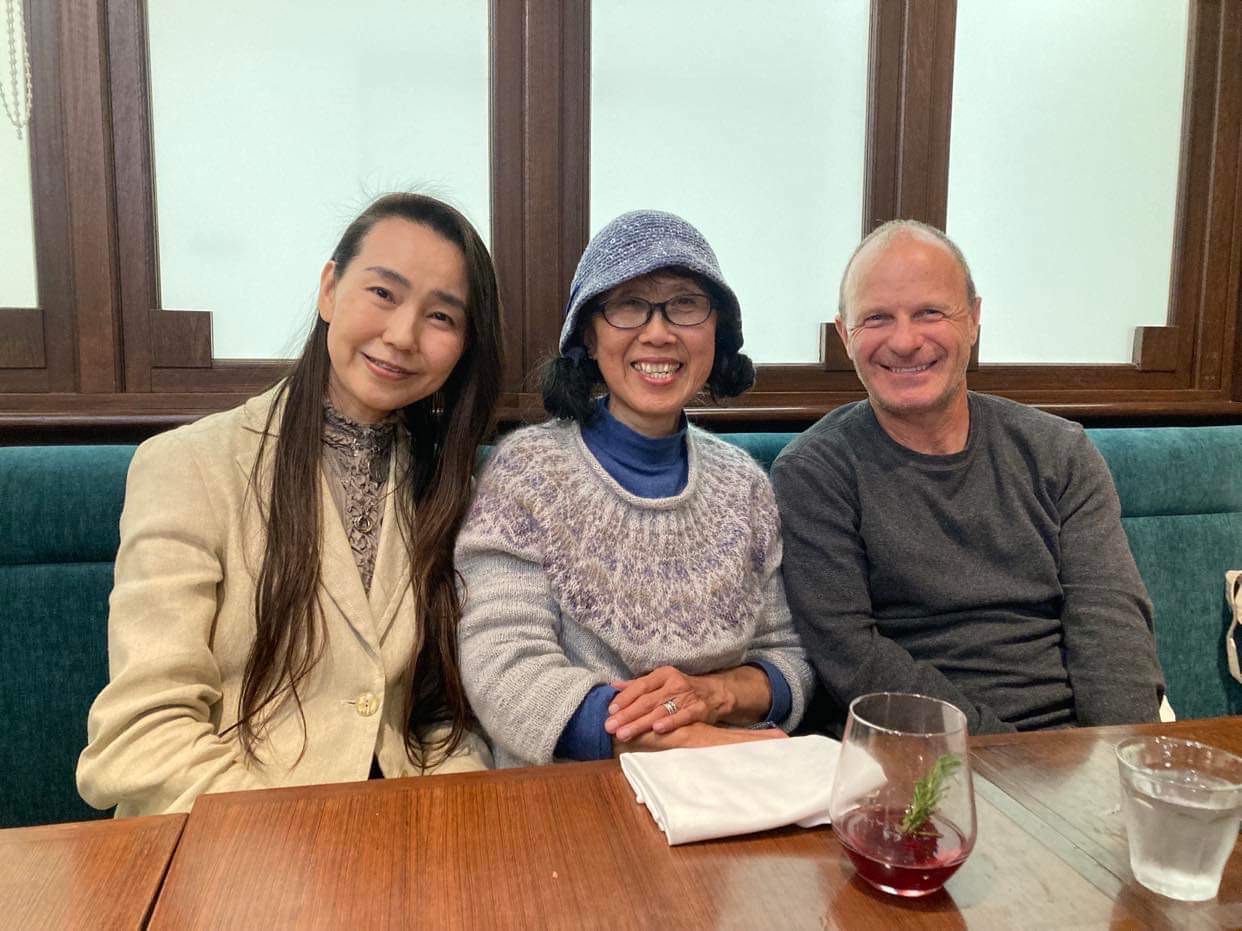
I felt that it would be great if we could keep in touch with everyone and hold Eric and my workshops and talks in Japan someday.
I had a good time chatting with them and felt sad to say goodbye, but after saying goodbye to everyone, Eric and I headed to Setagaya, our accommodation in Tokyo, and boarded the Odakyu Line from Shinjuku Station.
I have known my friend in Setagaya since I was at Pepperdine University in Malibu, CA.
Ringo-chan (a beagle dog) welcomed us there, and I gave her dog cookies, shampoo, etc.

After a long walk, I massaged my swollen feet in the bath and fell asleep with the excitement of connections of Japanese macrobiotics people on the second night.

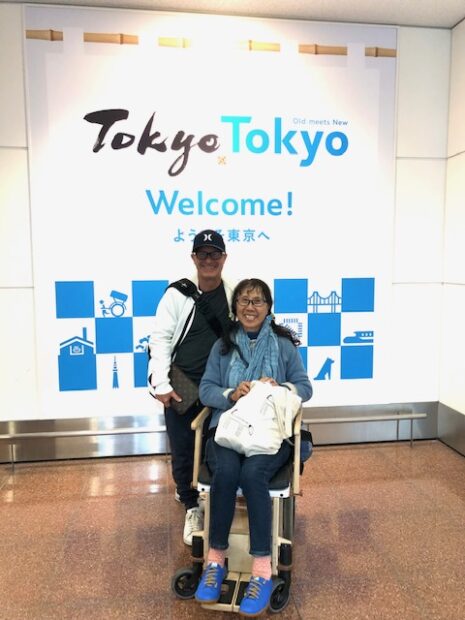
Japan Spring 2023 Diary Day 1 Chiba
Eric and I attended my niece’s wedding in Japan. We took this opportunity to enjoy our trip to Japan.
I share it as Japan Spring 2023 diary.
Day 1:
Eric and I arrived at Haneda Airport, Tokyo, at 4:30 am.
The flight was smooth, and the vegan meals I ordered were pretty decent, so I ate them with my brown rice onigiri.
I usually have difficulty sleeping in an airplane, so I watched two movies and started to knit my new sweater.
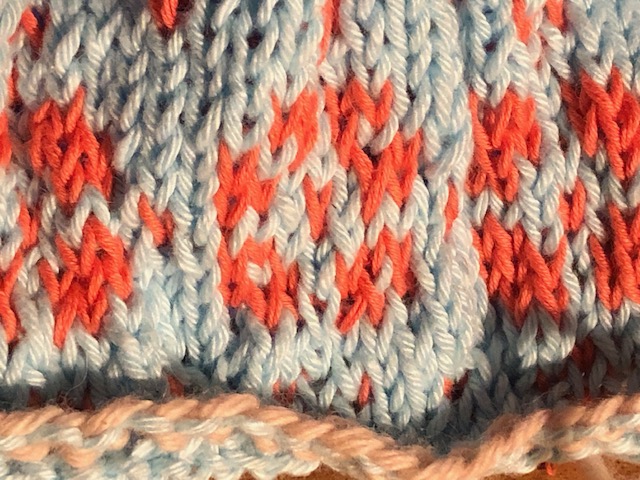
We left LAX around 1 am and 11 hours and a half later, still dark outside when we arrived in Tokyo. It was a wired feeling to have the darkness for a long time, and it did not make sense to my head, but the excitement of being in Japan for the first time in four years blew away the confusion.
I was supposed to be in Japan for my niece’s wedding two years ago, but because of the Pandemic, we had to wait for two years. The long waiting gave me more excitement.
I have been using a wheelchair in the airport to rest my legs since I injured my legs from a severe car crash in 2001. I was surprised to see a wooden wheelchair arrive for me to use. I have heard that Japan Airlines (JAL) has developed a wooden wheelchair for smooth movement within airport facilities.
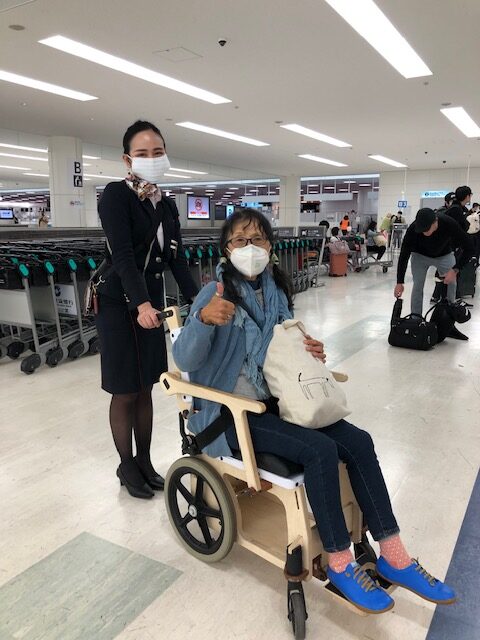
You can pass through the security checkpoint while using a wooden wheelchair. I have seen it on the NHK World News program (NHK is a Japanese public broadcaster offering local, national, and world news reports in English), but it was for the first time I used it.
I liked riding the wooden wheelchair because I felt that it was soft and connected to my body. Also, the person who assisted the wheelchair was polite, and she pushed it gently and slowly for me. I sure felt that I was in Japan.
Itsuko-san, who I met on the FB talk page “Body Joy” (she and Masayo are organizing the talk), was attending my class and kindly offered to pick us up at the airport. I felt this was a gift from heaven.
We did not know each other much, and it was our first meeting, but we felt we had known each other for a long time. We were talking and talking so much about Flower Remedy, Animal Communication, and more.
Eric suddenly said, “Are we going to under the water”?

Yes, we were passing Tokyo Bay Aqua-Line, a rare road between the seabed and the sea. It is a toll road with a length of about 15.1 km(9.4 miles). About 10 km(6.2 miles) undersea tunnel “Aqua Tunnel” on the Kawasaki side and about 4.4 km(2.7 miles) bridge “Aqua Bridge” on the Kisarazu side. Eric got so excited for the first time going under the water/bay road.
We all felt the ride was fast after Tokyo Bay Aqua-Line went through the countryside.
We arrived at Brown’s Field, welcomed by our long-time friend, Deco Nakajima, who has operated her organic rice field for 20 years.
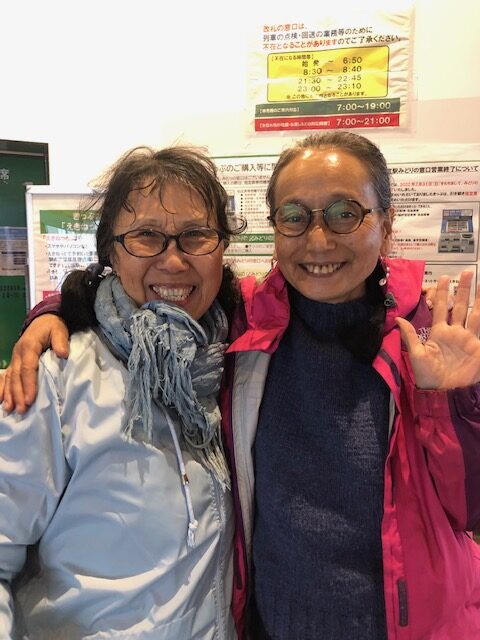
We had breakfast and visited Matinee (Deco’s daughter) ‘s first baby. The baby, Sui, was so precious.
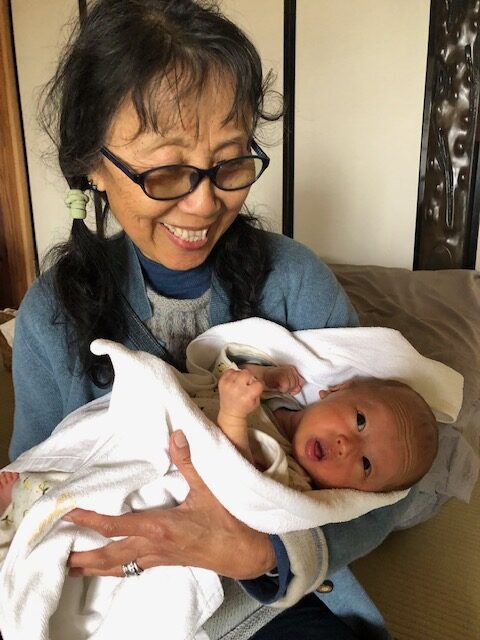
I have helped 45 puppies to be born and raised, so I have no problem holding puppies but holding a human newborn was scary for me. I could not have a baby because I had ovarian cancer.
It was a breathtaking moment!
We had Deco’s delicious homemade “Cherry Azuki beans steamed bread” there. So beautiful to see pickled Cherry Blossoms.
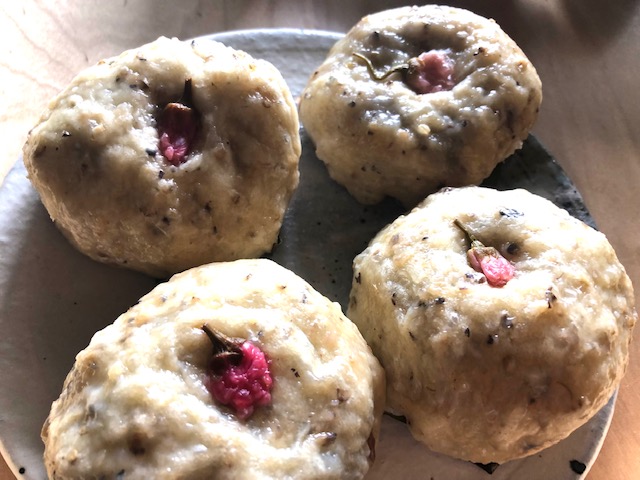
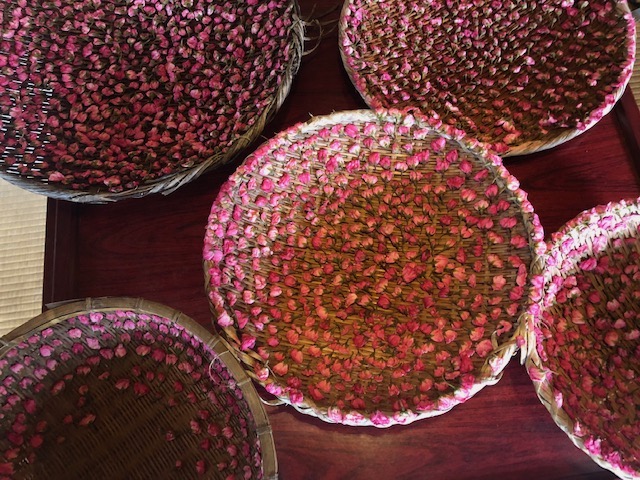
Then we went to the Kujyuu Kurihama beach, where Eric planned to Foil surf with a local Foil surfer, Jun Adegawa, who owns a surf shop, “Ted.”
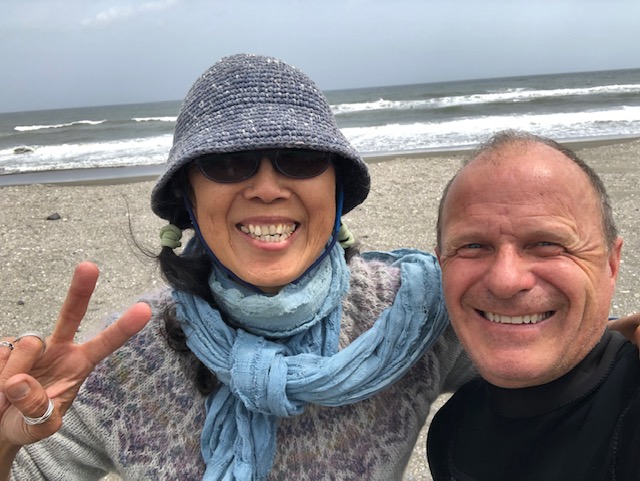
The powerful windy day for foil surfing.
I heard about the Kujyuu Kurihama beach a long time ago as a child. Most of the beach in Japan does not have long white sand beaches like here in Santa Monica, so when I heard that Kujyuu Kurihama has 41 miles of long white sand beach, I wanted to go there someday. It was like a dream that I was there now.
Eric started to Foil Surfing almost right away.
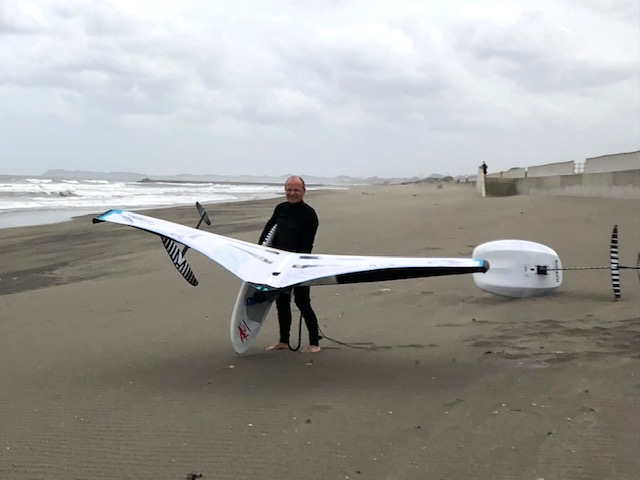
Itsuko, her dog, Chacha Maru, and I also enjoyed the beach with the wind. It was Chacha Maru’s first time on the beach, and he had so much fun.
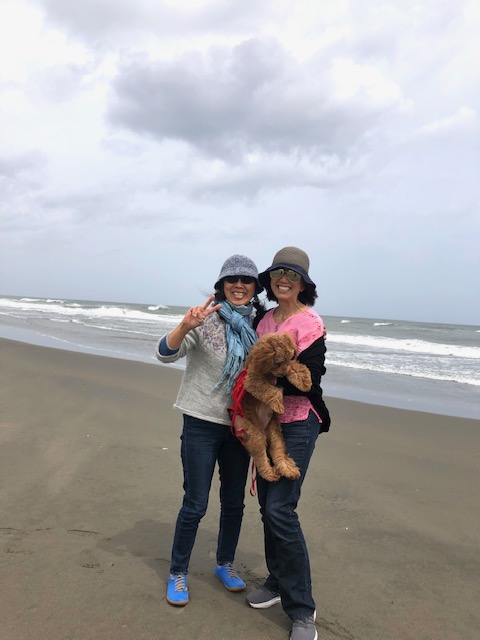
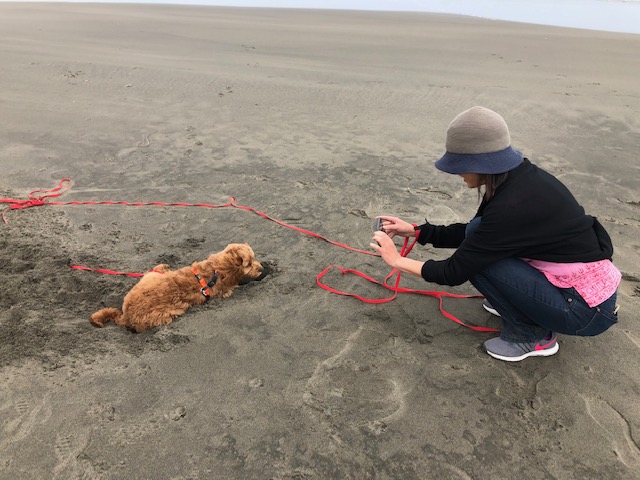
Eric stayed at the beach for Foil Surfing, I returned to Brown’s Felid with Itusko, had lunch at the Rice Terrace Cafe, and prepared for my Spring Flower Remedy and Medicinal Tea with Macrobiotic class.

While I was having lunch, Eric met other local Foil surfers and kept surfing for over 3.5 hours. He was supposed to finish his Foil Surfing in two hours and return to Brown’s Felid to eat lunch and help me with my class, but he must enjoy surfing so much!

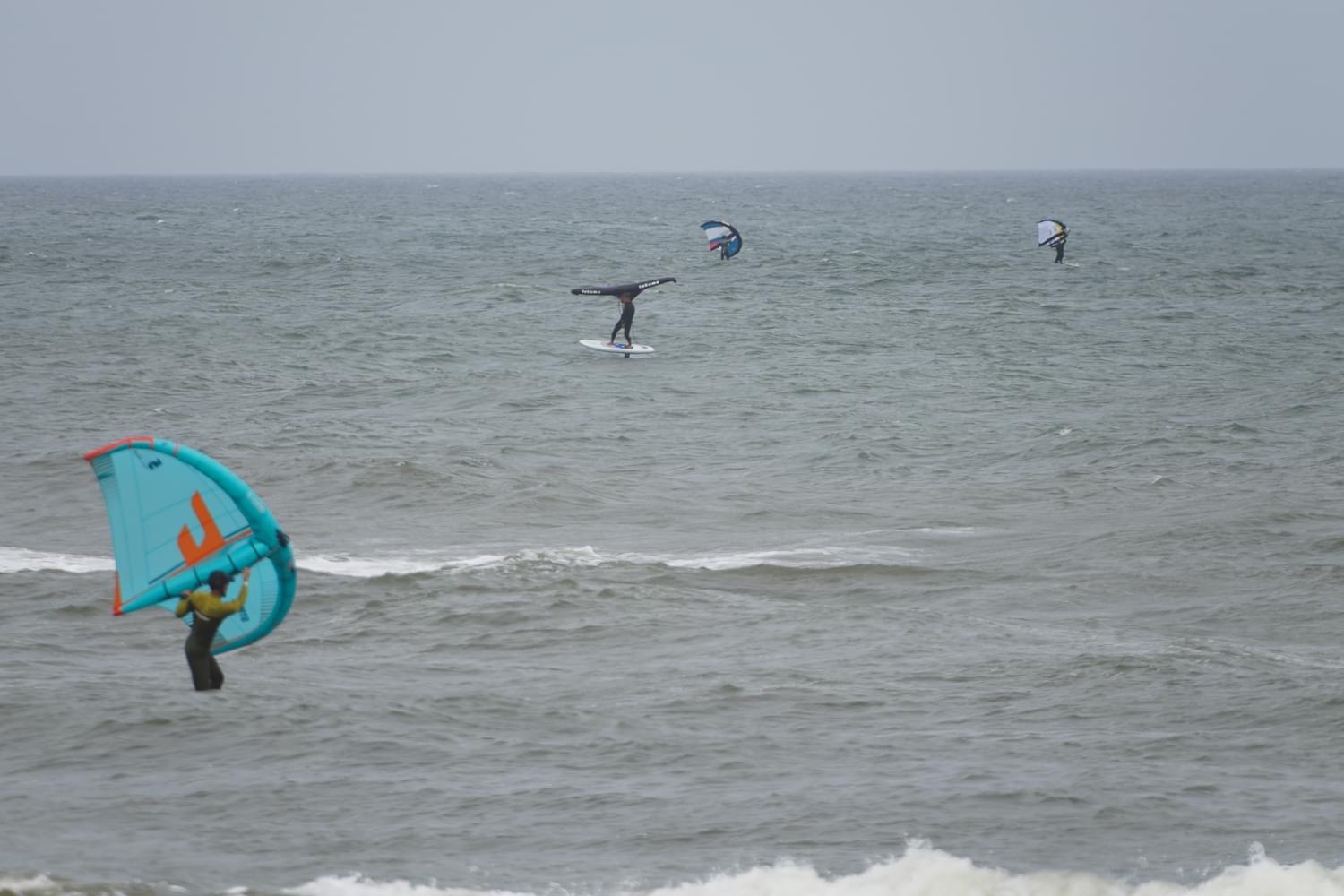 I could not believe Eric could Foil Surfing for so long the day we arrived in Japan. I was so impressed by Eric, who was full of stamina.
I could not believe Eric could Foil Surfing for so long the day we arrived in Japan. I was so impressed by Eric, who was full of stamina.
When he returned to Brown’s Field, he was so excited that how much fun he had with local surfers and met Jun’s family.
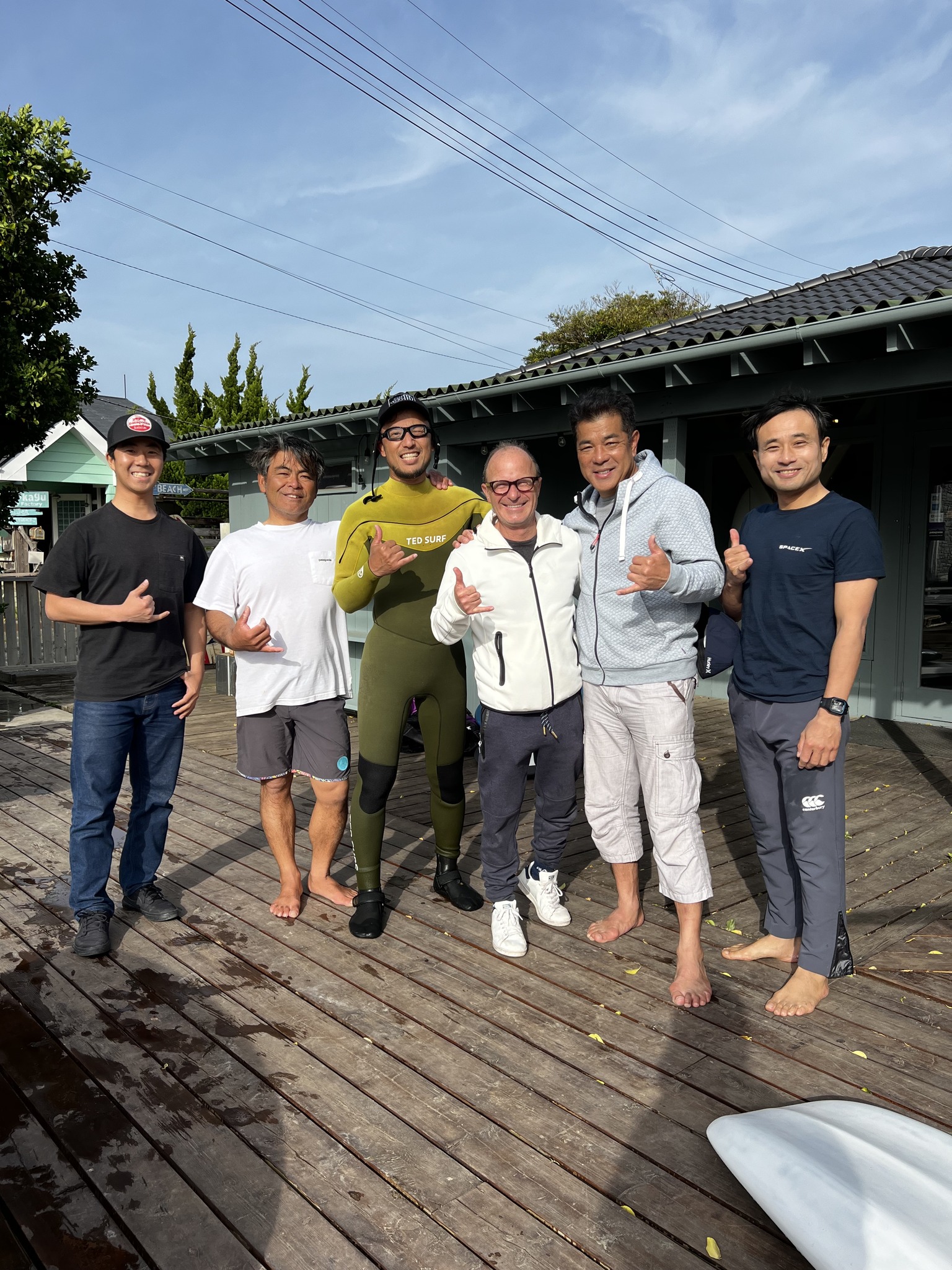
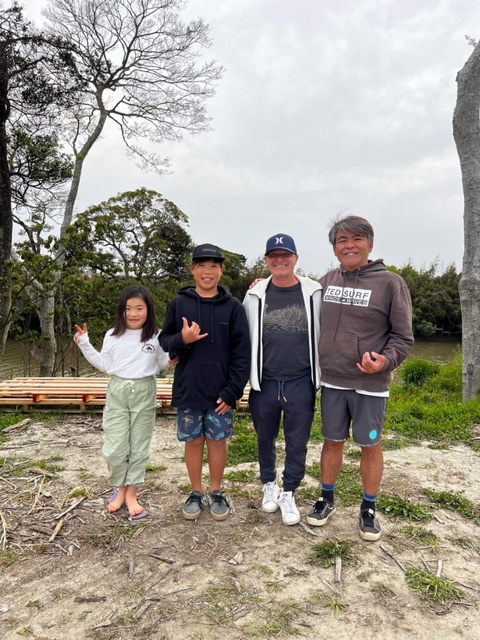 Eric also thanked me for giving him the brown rice ball I made in Santa Monica before I left the beach. He was, of course, still very hungry. I was glad that I did not eat my lunch everything so I could give him.
Eric also thanked me for giving him the brown rice ball I made in Santa Monica before I left the beach. He was, of course, still very hungry. I was glad that I did not eat my lunch everything so I could give him.
My class went very well with the help of the students. I did not teach in Japan for a long time, so I was concerned about how I teach; I carefully prepared in Santa Monica, bringing pressed medicinal plant leaves and three blended medicinal plants teas I made, etc.
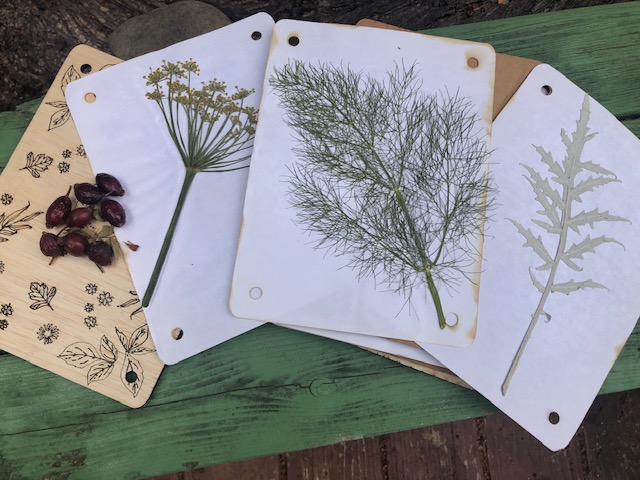
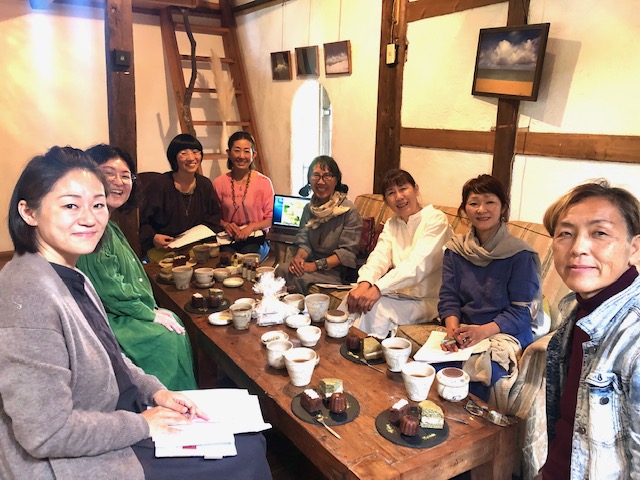
I enjoyed it a lot.
Participants were all to learn enthusiastically and asked questions mannerly and politely. This class was also successful because of the help of Keiko-san, who took my online Flower Remedy classes last year. She is a foot massage therapist and gave me a foot massage after the class. Her strength showed how she massaged my foot; it was a special treat.
All the Brown’s Field staff and volunteers made the delicious dinner with Deco. Our favorite was bamboo balls with Kuzu sauce and Ume Shio condiment. It was heart-warming to spend time with a long-time friend, Deco-chan, and a new friend, Itsuko-san, with people at Brown’s Field.
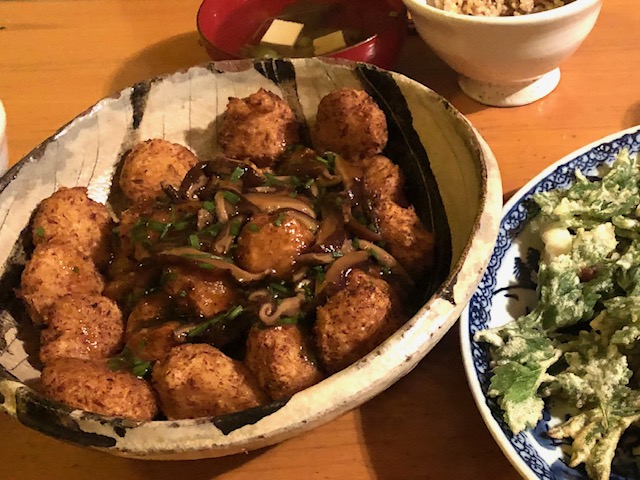
At night, when I was lying on a comfortable futon, I heard a chorus of frogs, and I went out and sat down around 3 am.
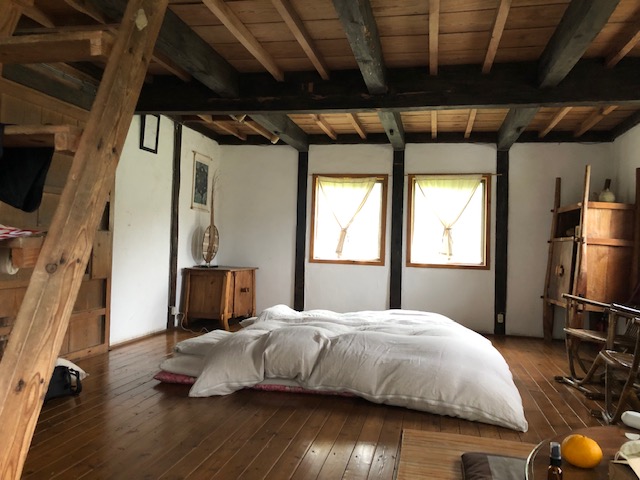
The sky was cloudy and unfortunately I could not see any stars and the rice fields were pitch black as if my eyes were closed.

Only the sound of frogs put my mind at rest.
It was my first day of Spring 2023 in Japan.
❤️Sanae
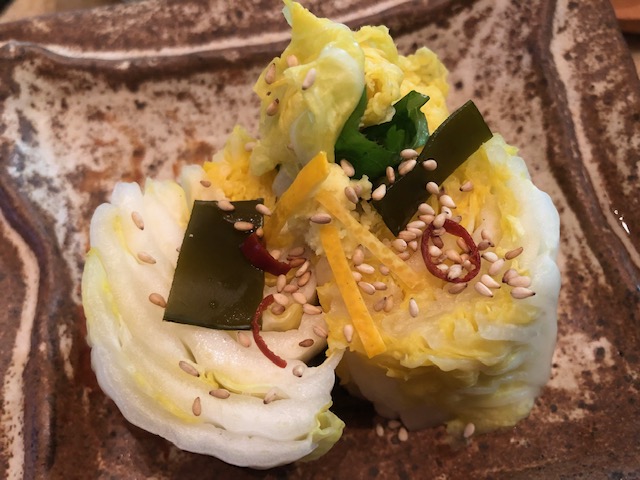
Spring is Pickles Time!
I have learned a lot since I moved to America, and the Five Elements of Macrobiotics were one of the significant lessons that changed my life.
I grew up in Japan, where people live seasonally.
The four seasons are commonly heard of, but traditionally people have lived by the five seasons of spring, summer, late summer, autumn, and winter, so it made sense to me.
It also reminded me of the *”seasonal hand-work” that my grandmother and mother used to do when I was little. *”seasonal hand-work” means making something with your hands each season.
I started to follow the seasonal rituals of Japanese tradition much later as I began to appreciate nature and season changes, even while living in Santa Monica in Southern California, where the five seasons are not as apparent.
Winter is not harsh here, but I noticed the contractions and tightness of the energy of the air and my own body so I appreciated the vegetables and fruits that grow in the winter.
Seasonal hand-work in January is making apple jam and citrus marmalade (usually mandarin). However, this year I made yuzu marmalade with my husband for the first time, and it came out very delicious. ), I also made kumquat syrup for sore throats.
February is miso-making. I make barley miso and rice miso in small amounts, and I feel the new year is here.
Then, spring suddenly emerges in Santa Monica and pushes winter out every year.
In spring the energy rises up, and the taste of sourness supports liver and gallbladder functions by the Five Elements.
I prepare my nuka doko (brown rice bran pickles bed/base)for nuka pickles: start roasting the new brown rice bran and adding it to the old nuka doko to prepare my nuka pickles for March.
I like daikon radish nuka pickles and kabu) (Japanese turnip) before the weather gets warmer. Once the weather gets warmer, I like cucumber nuka pickles. Another one is asazuke pickles (shorter-time pickles that taste more salad-like lightly pickled pickles).
In Japan, pickles (tsukemono) have been one of the staple foods, along with rice and miso soup, for a long time.
There were almost always pickles in each meal. I was not too fond of traditional Japanese pickles when I was younger because they smelled funny and were too salty and too sour. I only ate koji pickle, which had a sweet taste.
My mother always said, “Oh, you did not touch your pickles…finish your pickles. It is good for you!” She also often said, “Don’t worry you will like pickles when you grow up.”
She never told me why pickles were good for me and how much I had to grow before I like them, and I did not bother to ask.
When I came to America to study English, still, I didn’t like any of the American pickles, but I tried relish pickles, and I liked them because they were sweet.
When I studied Macrobiotics in 1993 for the first time, I found that pickles are essential to our meals. The processing of pickling allowed for the preservation of foods throughout history, and pickles are a staple food in various regions worldwide. Fermented pickles promote lactic acid bacteria, which help our digestion, strengthen intestines, assimilate food, and fight diseases. They provide the health benefits of fiber, vitamins, and antioxidants and increase appetite.
I have been loving all kinds of pickles since I have “grown up” enough to understand the benefits. I have been making homemade pickles, traditional Japanese pickles: umeboshi plum (you can see my blog for the recipe https://sanaesuzuki.com/2021/05/29/santa-monica-homemade-umeboshi-plums/), nuka pickles, and nontraditional pickles called asazuke (short-time pickling), like pressed salad in Macrobiotic recipes.
I had read in Japanese historical literature that pickles started in the Nara era (710~794) as preserved food with salt. It showed that vegetables such as eggplants and melons, as well as fruits such as peaches, were pickled in salt, mainly for temple monks as side dishes.
In the Heian era (794~ 1191), pickles were introduced as side dishes: bracken, butterbur, and melons were pickled in salt in the spring. Eggplants, persimmons, and pears were pickled in salt, miso, moromi (raw unrefined sake or soy sauce mash), and sake kasu (sake lees) in the fall.
In the Kamakura era (1180~1336) to the Muromachi era (1336~1537), because of the development of tea ceremonies and use of monkō (incense), people began to eat pickles more and more, and they learned not only to sense the taste and aroma with their senses of taste and smell, but to enjoy the atmosphere and aroma of the place with their heart. It can be said that this is related mainly to the fact that Japanese people enjoy a delicate and subtle sense of taste and smell. Pickles have the effect of renewing the sense of taste and smell, so they were served in tea ceremonies.
In the Edo era(1600~1868), the variety of vegetables increased, and many merchants from all over the country began to gather in Edo. As a result, different methods of making pickles were devised. Until then, foods were pickled for storage purposes, but research began to allow foods to be pickled for a short time for consumption more readily.
The emergence of nukazuke has had a major impact on household pickle-making. In times like this, when food shortages and conservation of the environment are of great concern, reusable rice bran beds are critical.
In the Meiji era(1868~1912), farmers in the suburbs of Tokyo and other urban areas started making takuan-zuke and narazuke (variety of Japanese pickles) as side businesses.
In the Taisho (1912~1926)and Showa (1926~1989) eras, the pickle manufacturing industry started to boom.
Over the years, there have been an amazing variety of pickles that have been made in Japan, and I am not kidding.
I heard there are currently over 1,200 pickle companies in Japan, and they make at least five~ten different kinds, so you can imagine how many pickles are made all the time besides local homemade ones, which each family has prepares with various recipes.
Most commercial pickles use instant seasoning MSG, non-natural salt, and sugar to numb consumers’ tongues and create false flavors. Making homemade pickles using quality natural ingredients is safer for our health and improves taste.
These are the nine pickles that are the main varieties in Japan today:
1. Salt pickles (shio zuke)
- Simplest and most common types of pickles.
2. Rice Bran (nuka zuke)
- Household pickles are fermented in a mixture of roasted rice bran (the hard outer skin of the rice that is removed when polishing the rice grain), salt, kombu, and other ingredients.
3. Sake Lees (kasu zuke)
- Pickles are preserved in a mixture of sake lees (the yeast mash that is left over after filtering sake), salt, sugar, and sweet cooking wine (mirin).
4. Vinegar (su zuke)
- Pickles brined in vinegar are known as Su zuke. Rice vinegar is commonly used as the pickling agent and lends a crunchy texture and sweet and sour flavor to the resulting pickles.
5. Miso (miso zuke)
- Pickles are made by covering vegetables in miso, a fermented soybean paste.
6. Soy Sauce (shoyu zuke)
- Pickles are preserved in a soy sauce base.
7. Koji pickles (koji zuke)
- vegetables, fish, other meat, etc., are pickled in base (toko/doko), which is made by mixing koji with sugar and salt.
8. Mustard (karashi zuke)
- Pickled in mustard mixed with sake and rice malt after being pickled in salt.
9. Lightly pickled (asa zuke)
- Pickled with seasoning for a short time. You can easily make it using various vegetables such as napa cabbage, radishes, and cucumber.
I want to share Japanese pickles recipes that I have been making for spring.
Nuka Pickle ((Brown Rice Bran Pickles) edited from Love, Sanae cookbook
It is my favorite pickle in spring-sour, salty, and pleasantly pungent taste with a satisfyingly crunchy texture and refreshing flavor.
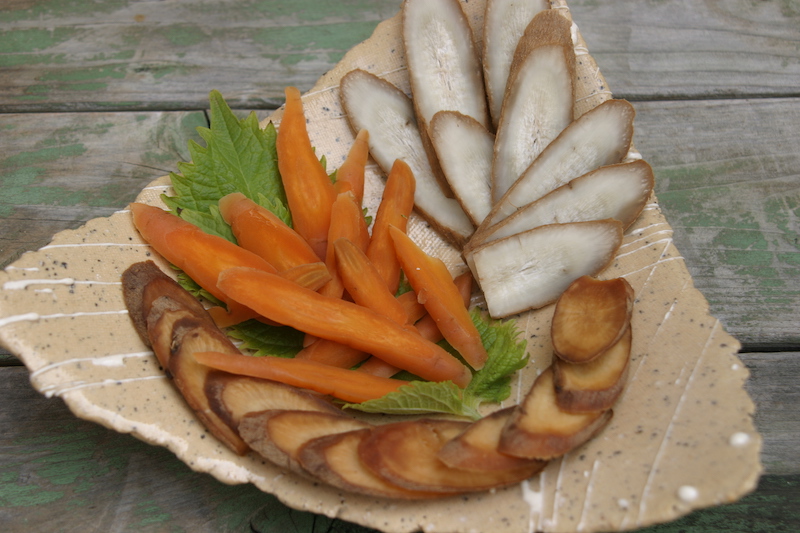
For the nuka bed:
1 pound nuka (brown rice bran)
2 cups purified water
2 to 4 tablespoons sea salt
2-inch square piece of kombu kelp (5cm)
one cup “starter” vegetables (carrots, cabbage, daikon, etc.), coarsely chopped
To make the nuka bed:
1. The first batch of nuka doko is very important in making nuka pickles. In a large skillet over medium-high flame., dry roast the bran (nuka) until the color changes slightly and the smell of bran intensifies. When evenly roasted, turn off the heat and allow it to cool.
2. In a small saucepan, boil the water. Add the sea salt and stir to combine. Add kombu, turn off the heat and let it cool.
3. Transfer cooled-off nuka to a ceramic crock, wooden barrel or enamel container. Add the kombu water mixture. Using your hands, gently combine the ingredients to form the nuka doko, or basis of the brown rice bran pickle bed.
4. Add chopped starter vegetables (dry them with a kitchen towel to take moisture out) which help to stimulate the fermentation process. Cover the crock with a clean cotton cloth and allow it to sit overnight.
5. Mix the nuka by hand once daily for the next 3 to 5 days. After this time, remove and discard the starter vegetables (I put them in the compost). The nuka doko is ready to make your delicious pickles.
6. Make sure vegetables (dry them with a kitchen towel to take moisture out) are ready to eat in a day, a couple of days to one week, depending on the kind of vegetables. Root vegetables and bigger sized vegetables take longer, and leafy vegetables and smaller sized vegetables take a shorter time.—For example, carrot- 2~3 days, red radish- 1 day, and small whole cucumber- 1 day.
7. Once you add vegetables, leave the crock in a cool dark area and mix vegetables daily.
If you cannot mix them daily, you can leave them in the refrigerator for a few days to a week. If you have kept it too long, the vegetables get more sour and salty, so make sure you rinse them with water.
If you are going out of town for a while, keep nuka in the refrigerator without vegetables. You can usually use the nuka bed to re-start making nuka pickles by adding a new roasted nuka to the old nuka bed to refresh.
Asazuke Napa Cabbage Pickle
Popular pickle with a refreshing taste for someone who loves crispy and light vegetables.
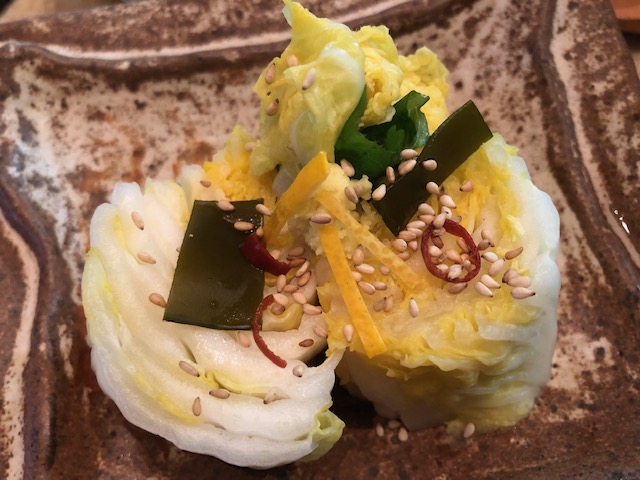
Ingredients
- 500 g napa cabbage (about half of whole)
- 80 g red radish (option)
- 20 g carrots (option)
Seasonings
- 10~20g sea salt 2~4% of the total weight of the vegetables
- 1 sheet kombu kelp 5cmx8cm/2”x 3.2″(Approximately 0.5 to 1% of the weight of the vegetables)
- 5 g ginger root shredded (optional)
- 2~4 dried red chili pepper without seeds sliced into rings to taste (optional)
- water (1/3 of the container)
- weight – Approximately 1.5 ~ 2 x of the weight of the vegetables
1. Gather all the ingredients.
2. *Cut napa cabbage: Make an incision about 5 cm (2 “) deep from the base of the napa cabbage and tear it into two pieces. It will make them not come apart. Furthermore, insert a kitchen knife in the same way, tear it apart, and divide it into four pieces. If the nap cabbage is large, you can split it into 6 to 8 pieces.
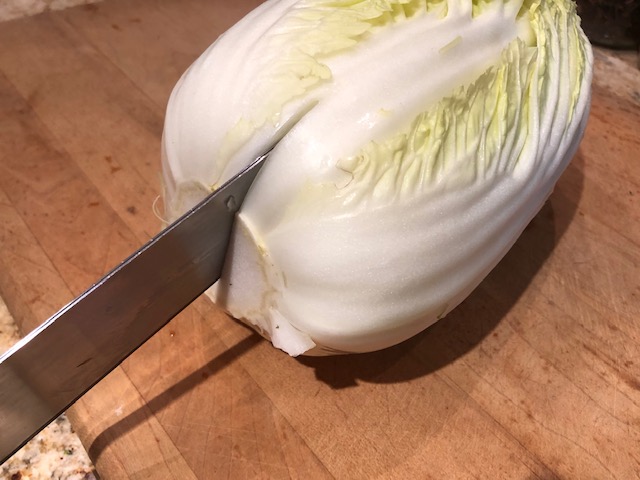
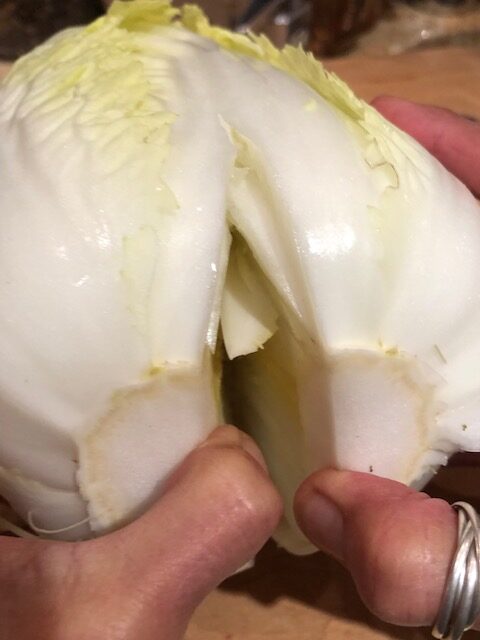
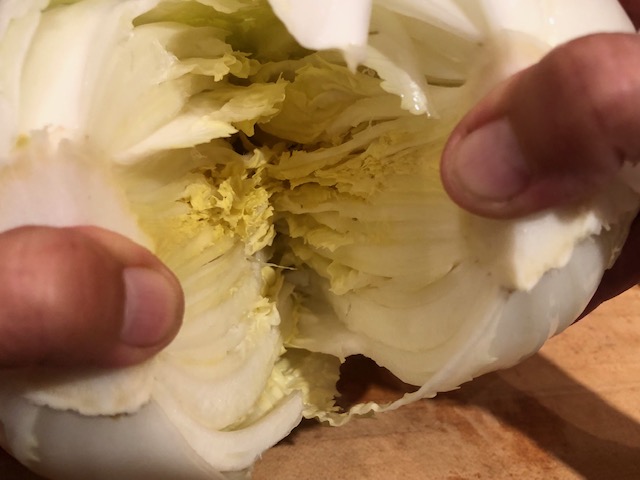
3. Add water to about 1/3 of the capacity of the pickle’s container and add salt to dissolve.
4. Arrange the cabbage in the same direction. If you need to layer the second ones, put half the salt on the first layer and sprinkle red chili pepper and kombu. Place the remaining napa cabbage in the opposite direction, place them in the second row, and sprinkle with the remaining salt. Press it firmly with your palm while applying it, which helps water rise easily.
5. Put a drop lid on it and use weight (I use big river rocks) to press.
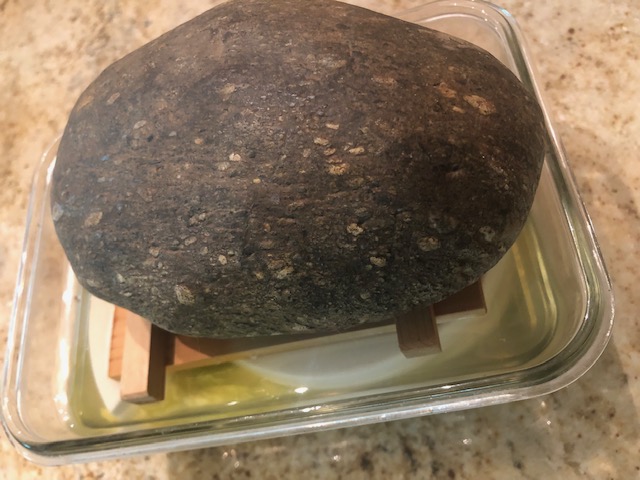
Cover with a thin cotton cloth and leave it for 12 ~ 24 hours (in colder times, leave it for 24~48 hours)
6. When you’re ready to eat, take out just the portion you’re going to eat, squeeze out the juice, rinse with water and squeeze it again.
7. Cut into bite-sized pieces before serving, and add **condiments if you like.
Note:
- Cut napa cabbage: if you want the cabbage to pickle faster, cut it into small pieces, but you may lose the crispiness.
- * Condiments: If you like, add roasted sesame seeds and citrus juice, such as yuzu or lemon or zest, and grated ginger to make it even more delicious!
Soy Beans Sprout Quick Pressed Salad Style Pickle
It is not like your usual pickles – My mother made this more to my liking, crispy like a salad and less salty, so I could enjoy it as a child, and I still love it as a side dish.
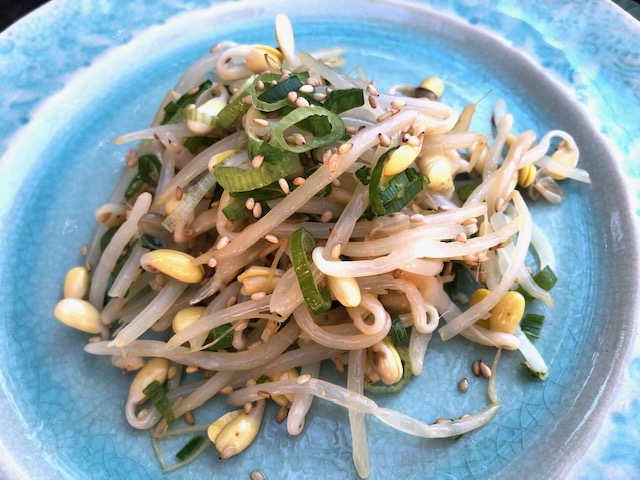
Ingredients
- 1 pound of soybean sprouts, rinsed and drained
- 1 teaspoon sea salt
- 1/2 cup water
- 1 green onion, chopped
- 1 teaspoon roasted sesame seeds
- 1~2 teaspoon toasted sesame oil
- 1~2 garlic clove, minced (option for people who eat meat/fish)
- Place soybean sprouts in a pot. Add the salt and ½ cup of water and cover. Bring to a boil over medium-high heat for 5 minutes. Drain.
- Put the cooked soybean sprouts in a mixing bowl. Add green onion, sesame seeds, and toasted sesame oil and mix well by hand.
- Put a lightweight plate as a lid over it to press for one hour.
- Transfer to a serving plate.
- Serve as a side dish to rice.
My pickles class on March 5th.
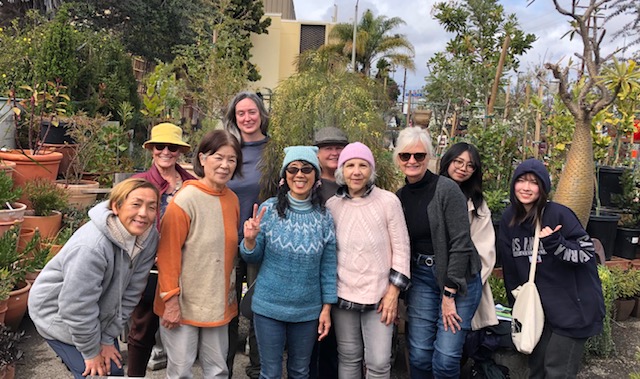
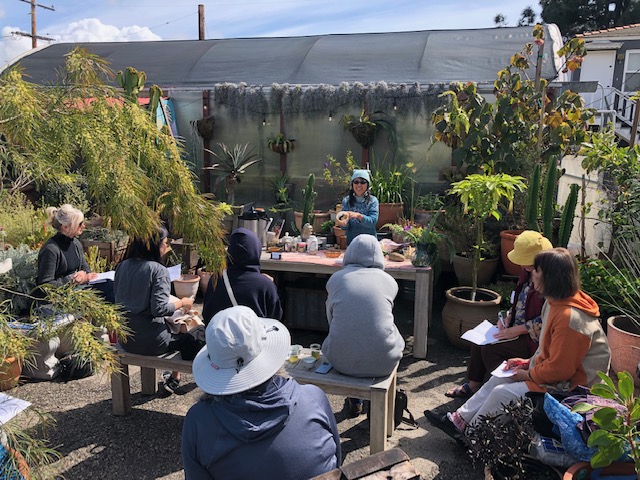
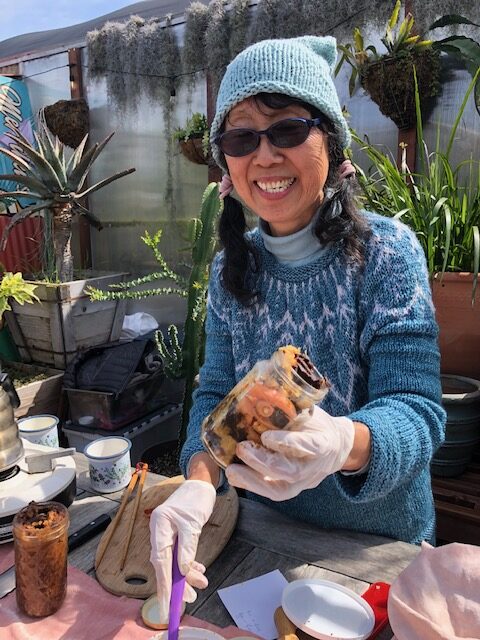
Enjoy your spring pickles!
Love, Sanae❤️
I wrote this article for “Macrobiotic Today” March 15th, 2023 Issue.
Subscribe for FREE: https://madmimi.com/signups/828f181e33dc41d0ae4d59bb5f4f2301/join
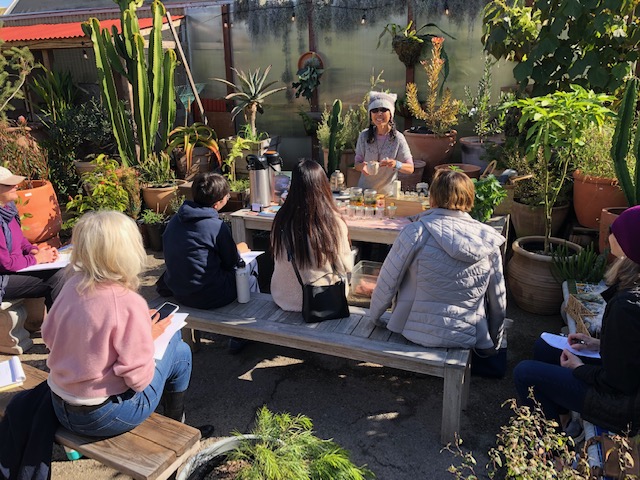
Nine Star Ki, Bach Flower and Medicinal Tea Class
Setsubun ((節分) is February 3, the day before the beginning of spring/the new year in the old calendar in Japan is over, and Nine Star Ki’s new year has started. (it starts the day after Setsubun).
This year’s my first class was held last weekend.
I taught Nine Star Ki, Bach Flowers, and Medicinal Tea (support winter organs, kidneys, and bladders).
See what kind of year you will be in 2023 at Nine Star Ki, and get help to spend this year mentally (emotionally) meaningfully at Batch Flower.
Traditionally, the Kyoko area has new year’s tea Obukucha (Kombu kelp and Umeboshi plum tea with green tea), but I chose the medicinal tea of Nettle instead of green tea with Kombucha kelp and Umeboshi plum for the class.
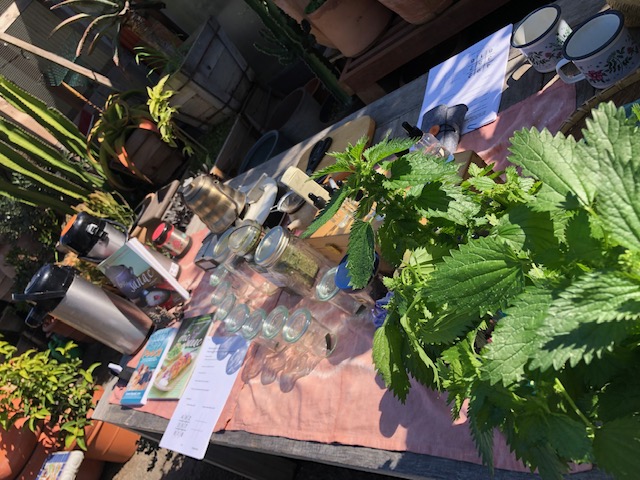
The hour-and-a-half class ended in no time.
First, I asked everyone to write down their goals from this year (and three years and ten years), what is preventing them from progressing toward that goal, and what they are doing to reach it.
After that, I explained briefly by checking everyone’s Nine Star Ki number.
Many people who participated in the class were with Three Tree. Other people were Two Soil, Four Tree, and Seven Metal.

This year’s Nine Star Ki is “Four Tree” in the center (above is Nine Star Ki Basic “Five Soil” is in the center). Four Tree is growing and prosperous in Nine Star Ki.
To thrive this year, we all need to be in shape. What does mean “need to be in shape”? It is not a physical shape the case.
In the class, I explained to everyone that after planting seeds of what you want to do and it sprouts, then thinning is sorting out/shaping up the things that have sprouted and grown and focusing on only the things you want to grow.
It also means that you must clean up what you have been procrastinating or not connecting with your feelings, so you also need to mentally and emotionally organize yourself.
For example, those who attended the class, especially for people with Three Tree are in the position of growing up more this year, so they need to be thinned out.
The person with the Two Soil was in the position of sowing seeds last year, so it is necessary to water and give the sunshine so the seeds will sprout and spend every day regularly.
People with Four Tree‘s nature is growing in Nine Star Kinninth, but this year they are in the center position. They might feel the energy from the left, right, up, and down (it means from everywhere or everybody)will come in, so they might support other people’s prosperity more than themselves. Remembering to support yourself to grow more this year is important.
Seven Metal person is the year of sowing this year. It’s the year to start new things.
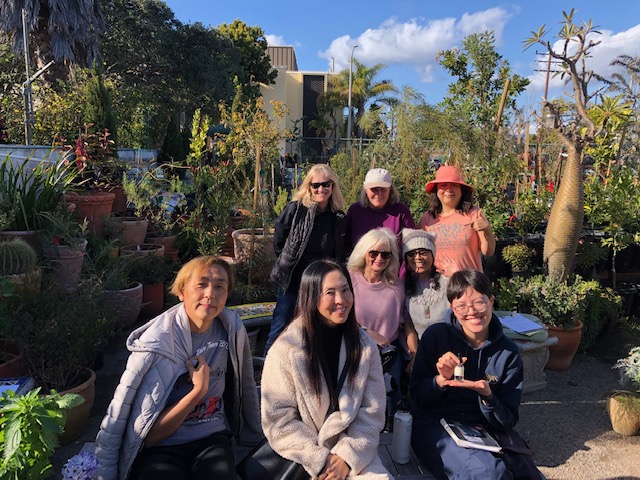
It’s different from Nine Star Ki, but this year’s Chinese zodiac is Water Rabbit year.
The Rabbit represents peaceful and patient energy. The Rabbit is a gentle creature known for thinking things through before acting. This energy will encourage us to approach challenges and opportunities calmly and rationally. In addition to the Rabbit’s peaceful energy, the Water element brings intuition and inner peace. Water is all about tapping into our inner wisdom and trusting our instincts. It encourages us to be more in tune with our emotions and sensitive to those around us.
As the Year of the Rabbit 2023 has come, it’s time to tap into its energy and make the most of it. Let’s focus on building strong connections with loved ones, colleagues, and anyone else in our lives. After all, the Rabbit is known for its ability to create and maintain harmonious relationships.
Next, let’s turn our attention to our careers. 2023 is the perfect time to focus on professional development and advancement. Take advantage of networking opportunities, build relationships with colleagues, and even consider taking on new projects or additional responsibilities.
Of course, the Rabbit represents wealth and prosperity, so according to the Chinese horoscope 2023, it’s a great time to focus on our finances and work towards increasing our income. Whether it’s investing in stocks, property, or other types of savings plans, now is the time to make smart financial moves.
But let’s remember the importance of being cautious. The Rabbit is also associated with trustfulness and an easygoing attitude, but it’s essential to be vigilant regarding potential scams or frauds. Trust, but verify.
On a more creative note, the Rabbit is also associated with creativity and artistic talents. So, let’s tap into our inner artists and explore our creative side. The possibilities are endless, whether it’s taking up a new hobby, trying your hand at painting, writing, or any other form of art that you’re interested in.
Lastly, the Rabbit is also associated with taking care of oneself, so let’s prioritize self-care and maintaining a healthy lifestyle. Eating well, exercising regularly, and getting enough sleep will help us stay balanced and take advantage of the positive energy of the year. By following these tips, we can make the most of the Year of the Rabbit 2023 and take advantage of the positive energy and opportunities it brings.
[Source: The Chinese Zodiac]
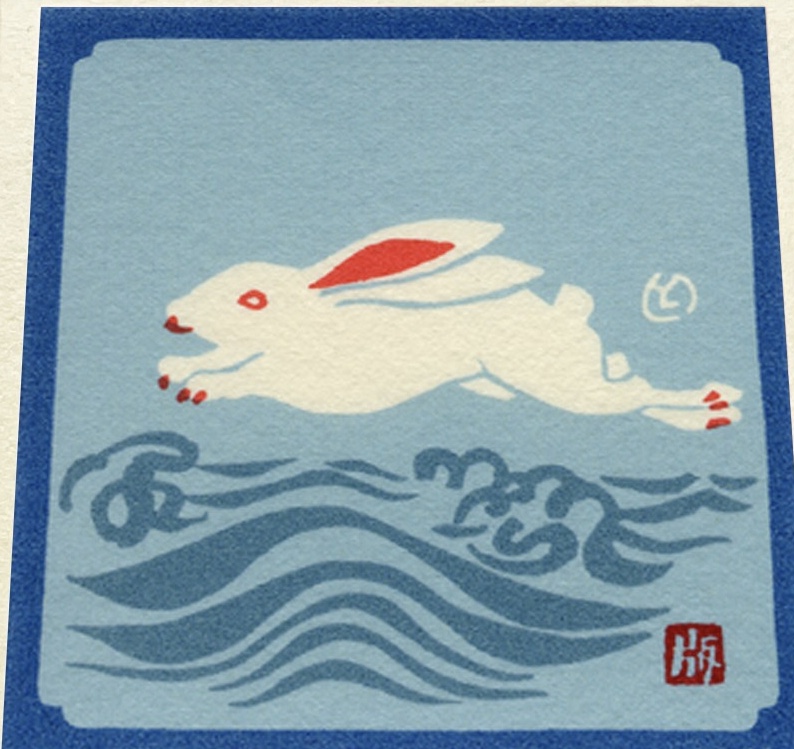
Bach Flower Remedy.
I asked people what they were going through emotionally and mentally.
These are examples of people who attended classes that they needed for Bach Flower Remedy recommendations:
Person in transition – Walnut
People who can’t see the future – Wild Oat
Anxious people – Mimulus
Those who feel resentment for what happened – Willow
Setback – Gentian
People who are taking care of their families all the time and are overwhelmed by responsibility – Elm
Overthinking – White Chestnut
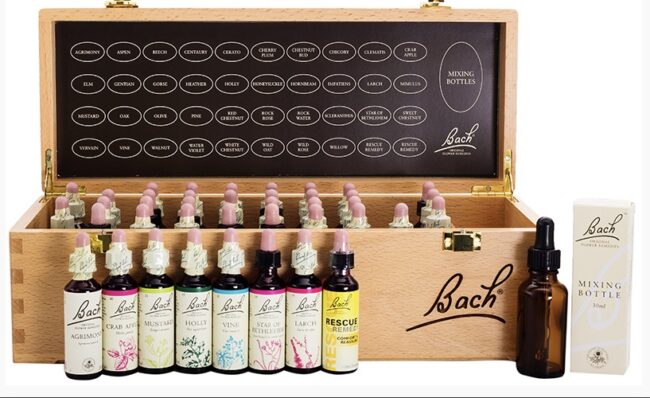
Everyone got their remedies to take home. They will take 2 drops of Bach Flower Remedy at least 4 times a day for 1-2 weeks. I look forward to seeing how all students progress with their remedies.
For the Medicinal Tea, I chose Nettle, which is rich in minerals and suitable for the New Year.
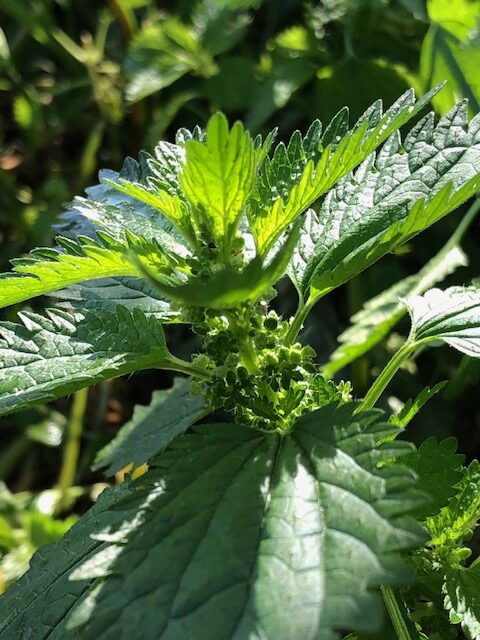
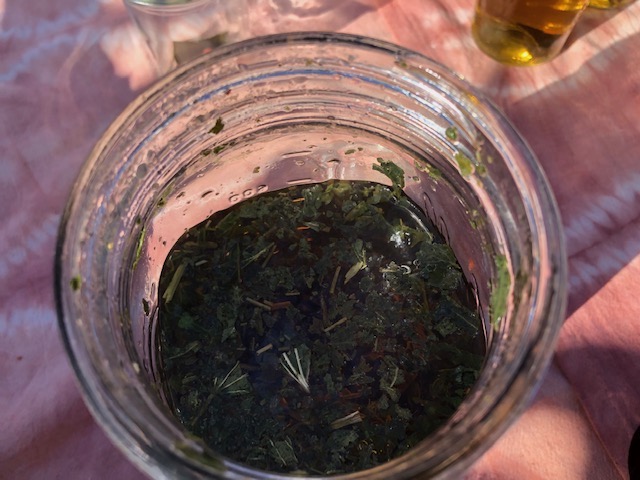
For the New Year, Kombu kelp (I get it from The Seaweed Man)and Umeboshi plum (Check my blog: Santa Monica Homemade Umeboshi plums)with green tea is a traditional drink in the Kyoko area in Japan.
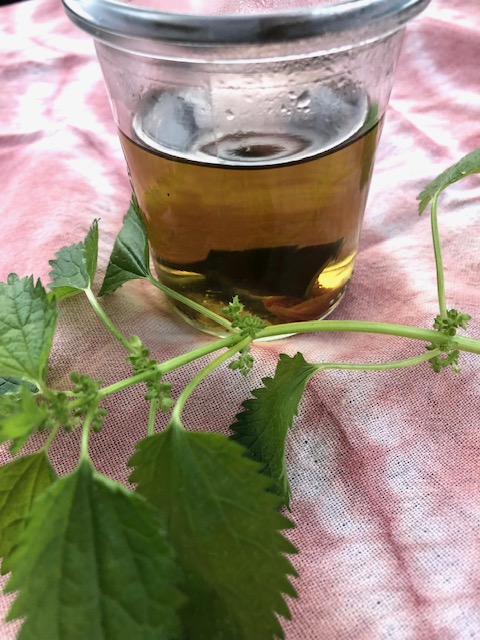
Nettle instead of green tea, which supports the kidneys and bladder and is also beneficial for the liver and lungs.
Kelp benefits the kidneys, bladder, liver, and stomach.
Umeboshi is an alkaline food that aids intestinal function and relieves fatigue, detoxifies, sore throat, fatty liver, and cholesterol, and purifies water.
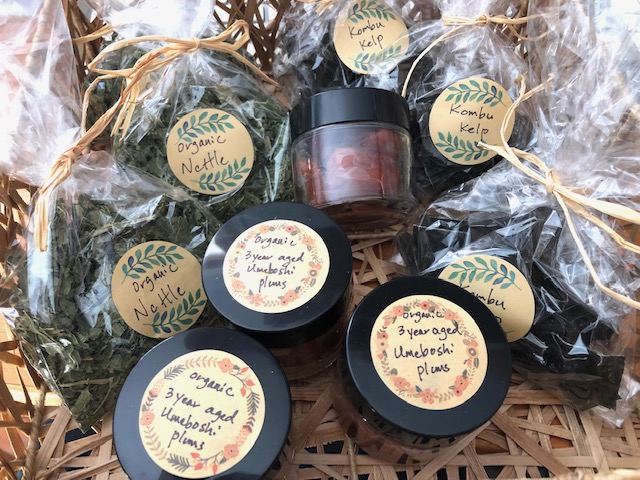
Herbal tea is easy to make at home, and you can drink it and take care of yourself.
Please give it a try.
Love,
Sanae❤️
Please email me if you are interested in Bach Flower online classes or individual consultations.
Also, if you are interested in Medicinal Tea consultation, please let me know by email.
sanaehealing@gmail.com
